Our verdict
Pros
- Cushioned and comfortable
- Excellent grip across diverse terrains
- Outstanding Vibram Megagrip outsole
- Noticeably lighter than previous models
- Robust and long-lasting upper
- Adaptable to multiple paces
- 100% ready for ultras
- Enhanced flexibility compared to previous versions
Cons
- Ankle collar design favors debris intrusion
- Excessive foam exposure might be a concern
- Not for wide feet
Audience verdict
- Top 28% in trail running shoes
- Top 24% in Hoka running shoes
- Top 28% most popular running shoes
Comparison
The most similar running shoes compared
+ + Add a shoe | |||||
|---|---|---|---|---|---|
| Audience score | 88 Great! | 77 Decent! | 81 Good! | 87 Great! | |
| Price | $185 | $185 | $85 | $160 | |
| Trail terrain | ModerateTechnical | Light | Light | ModerateTechnical | |
| Shock absorption | Moderate | - | Moderate | High | |
| Energy return | Moderate | - | Low | Moderate | |
| Arch support | Neutral | Neutral | Neutral | Neutral | |
| Weight lab Weight brand | 10.3 oz / 293g 10.4 oz / 295g | 11.7 oz / 332g 11.6 oz / 329g | 10.3 oz / 292g 10.4 oz / 296g | 10.6 oz / 301g 10.6 oz / 301g | |
| Drop lab Drop brand | 7.2 mm 4.0 mm | 3.9 mm 4.0 mm | 10.1 mm 8.0 mm | 7.1 mm 4.0 mm | |
| Strike pattern | Mid/forefoot | Mid/forefoot | Heel | Mid/forefoot | |
| Size | True to size | Slightly small | True to size | True to size | |
| Midsole softness | Soft | Soft | Balanced | Soft | |
| Difference in midsole softness in cold | Normal | Normal | Normal | Normal | |
| Toebox durability | Good | Very good | Very bad | Very bad | |
| Heel padding durability | Good | Decent | Bad | Decent | |
| Outsole durability | Good | Good | Decent | - | |
| Breathability | Moderate | Moderate | Moderate | Moderate | |
| Width / fit | Medium | Narrow | Medium | Medium | |
| Toebox width | Narrow | Narrow | Medium | Narrow | |
| Stiffness | Moderate | Stiff | Flexible | Moderate | |
| Torsional rigidity | Stiff | Stiff | Stiff | Moderate | |
| Heel counter stiffness | Flexible | Moderate | Stiff | Moderate | |
| Lug depth | 3.9 mm | 4.0 mm | 4.0 mm | 5.0 mm | |
| Heel stack lab Heel stack brand | 38.0 mm 33.0 mm | 35.6 mm 35.0 mm | 37.7 mm 36.0 mm | 38.6 mm 39.4 mm | |
| Forefoot lab Forefoot brand | 30.8 mm 29.0 mm | 31.7 mm 31.0 mm | 27.6 mm 28.0 mm | 31.5 mm 35.4 mm | |
| Widths available | Normal | Normal | Normal | NormalWide | |
| For heavy runners | ✗ | ✗ | ✓ | ✗ | |
| Season | All seasons | All seasons | All seasons | All seasons | |
| Removable insole | ✓ | ✓ | ✓ | ✓ | |
| Orthotic friendly | ✓ | ✓ | ✓ | ✓ | |
| Ranking | #132 Top 36% | #334 Bottom 10% | #297 Bottom 20% | #160 Top 43% | |
| Popularity | #103 Top 28% | #202 Bottom 45% | #205 Bottom 45% | #27 Top 8% |
Who should buy
We believe the Hoka Mafate 4 is an outstanding pick for:
- Trail enthusiasts seeking a reliable and durable all-terrain shoe.
- Devotees of Hoka's road shoes looking for a cushioned trail companion.
- Ultrarunners who need a versatile, high-mileage workhorse for their training and racing.
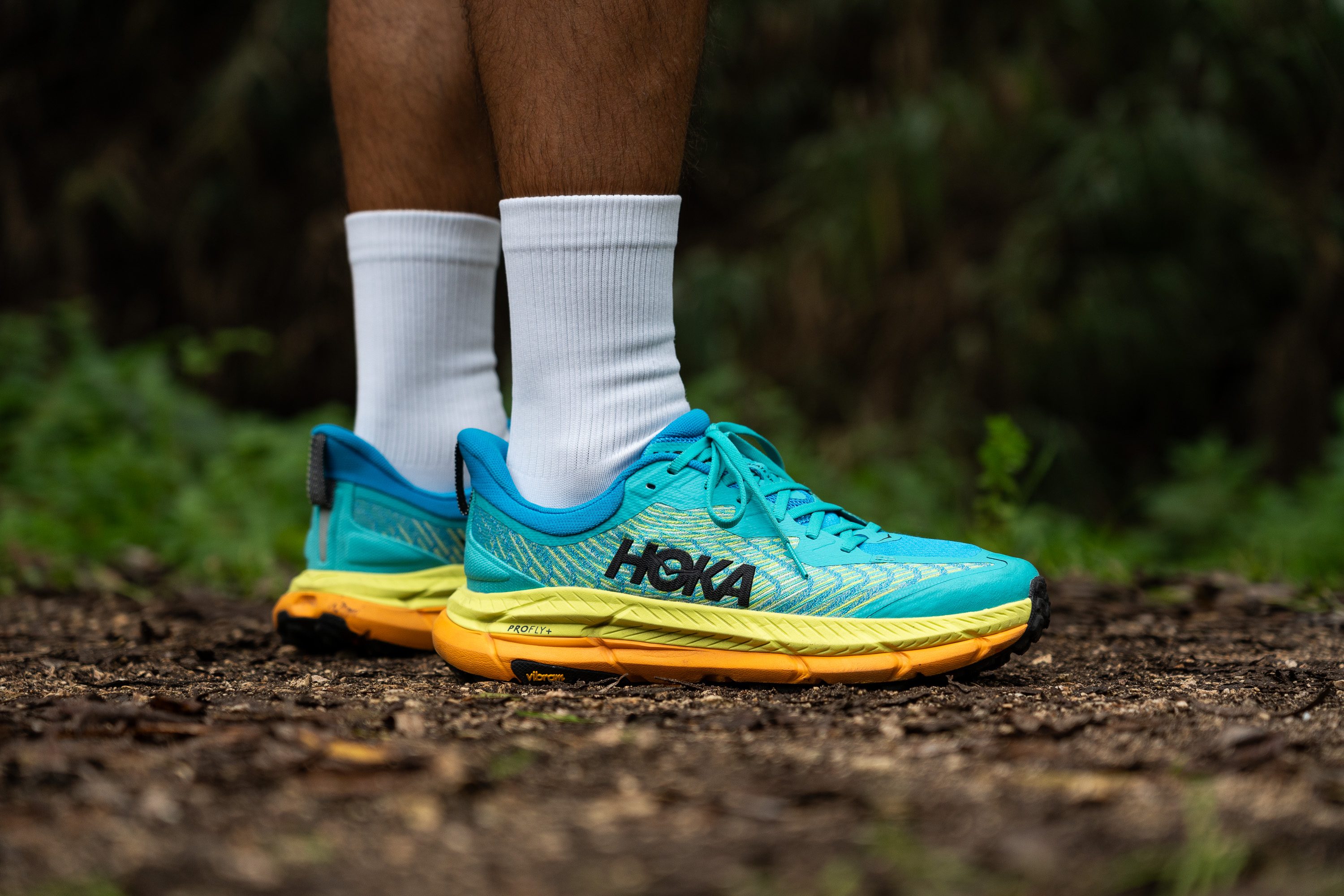
Who should NOT buy
If you're often tackling terrain with small rocks and debris, the Mafate Speed 4 might not be your best bet. Its heel design tends to attract and trap debris, potentially disrupting your runs. Instead, opt for a model without this design flaw, such as the Nike Wildhorse 8 or the Saucony Peregrine 13.
Additionally, for runners seeking pure speed on flat trails, we believe the Mafate's 4-mm lugs and average-at-best energy return may not be the best choice. In these scenarios, we think you're likely to benefit more from a trail shoe with shorter lugs, Pebax midsole technology, and a carbon plate. Options like the Nike Ultrafly or the Saucony Endorphin Edge could better meet your needs.
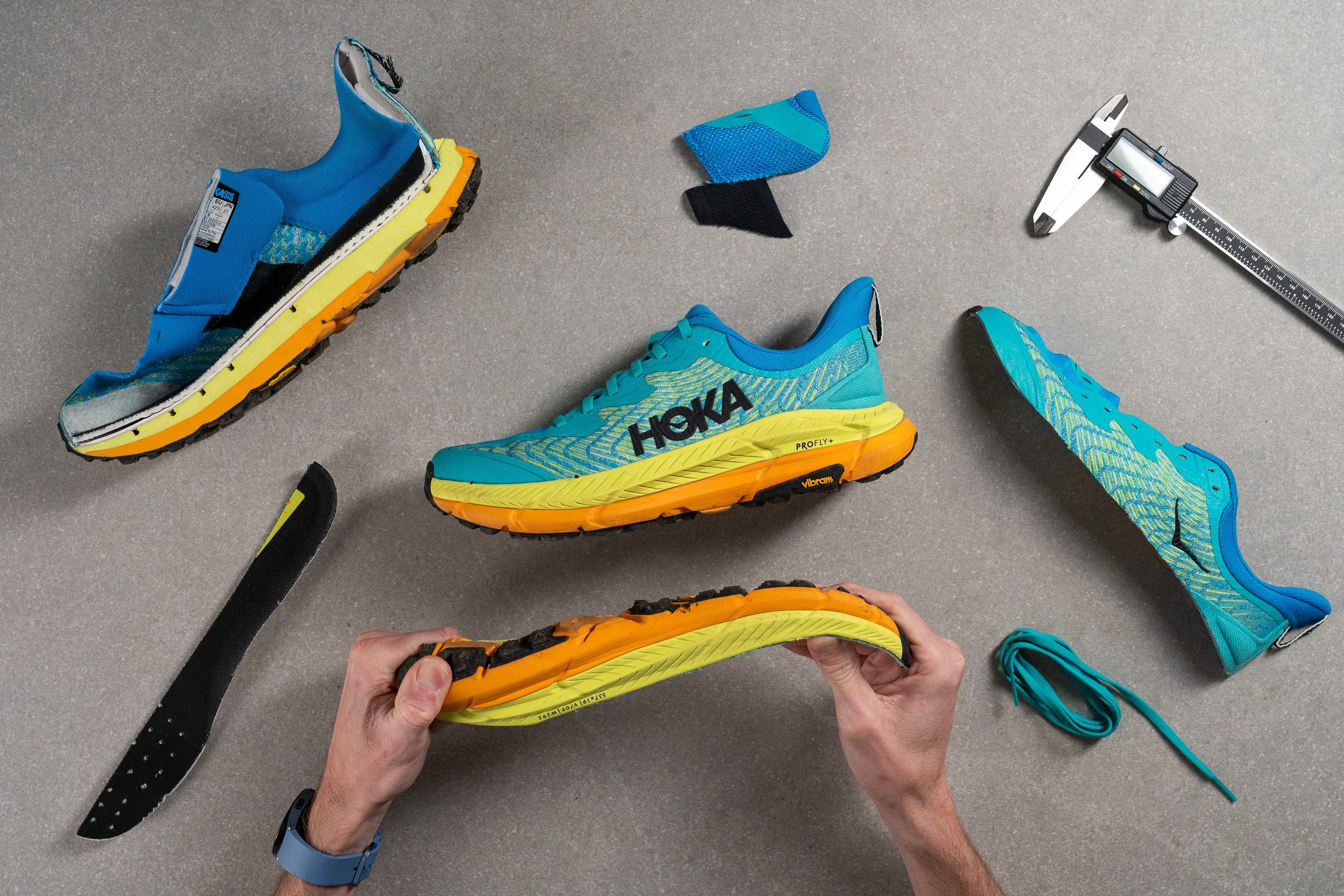
Cushioning
Shock absorption
The Mafate Speed 4 stands out in HOKA’s lineup as a top choice for long distances, thanks to its high shock absorption.
We felt well-cushioned during mountain runs, and back in the lab, we measured 129 SA in the heel and an impressive 118 SA in the forefoot, clearly outperforming most shoes in its category.
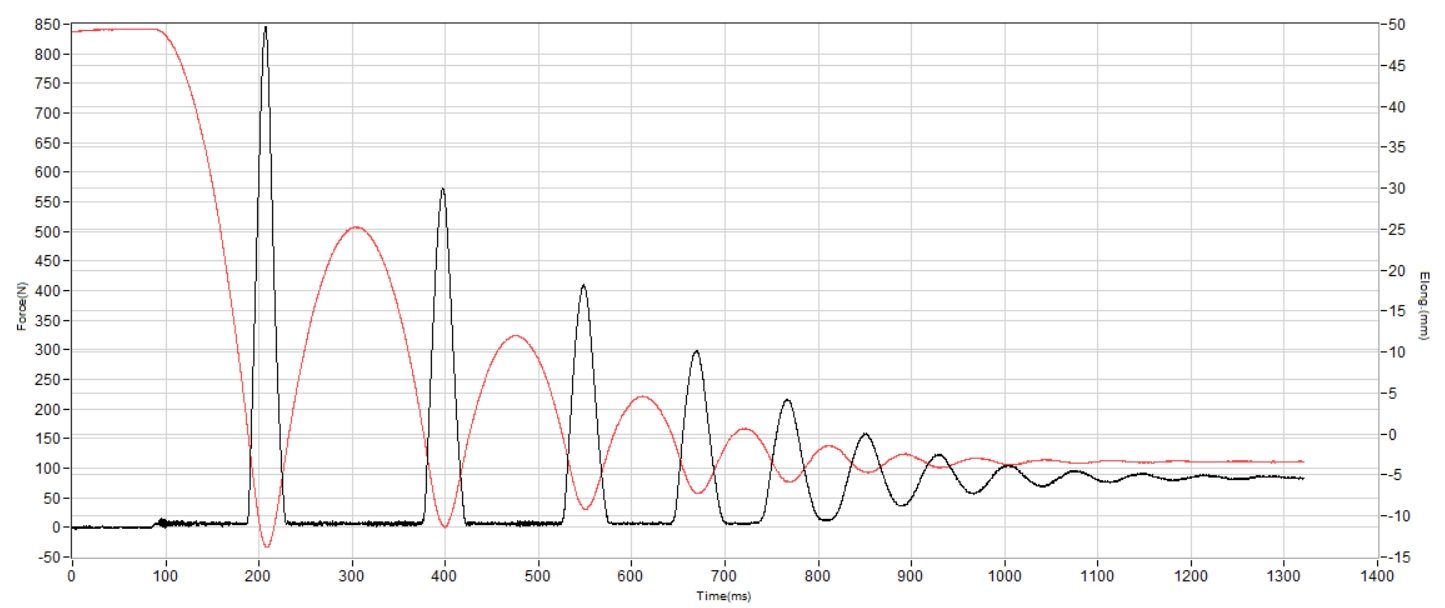
| Hoka Mafate Speed 4 | 129 SA |
| Average | 122 SA |
Energy return
Energy return is also better than in other HOKAs, making this an interesting option if bounce matters to you. While 58.3% won’t break any records, it delivers a smooth ride with a touch of responsiveness.
| Hoka Mafate Speed 4 | 58.3% |
| Average | 55.6% |
Heel stack
We just touched on the stack height, and now it's time to check its measurements in the lab.
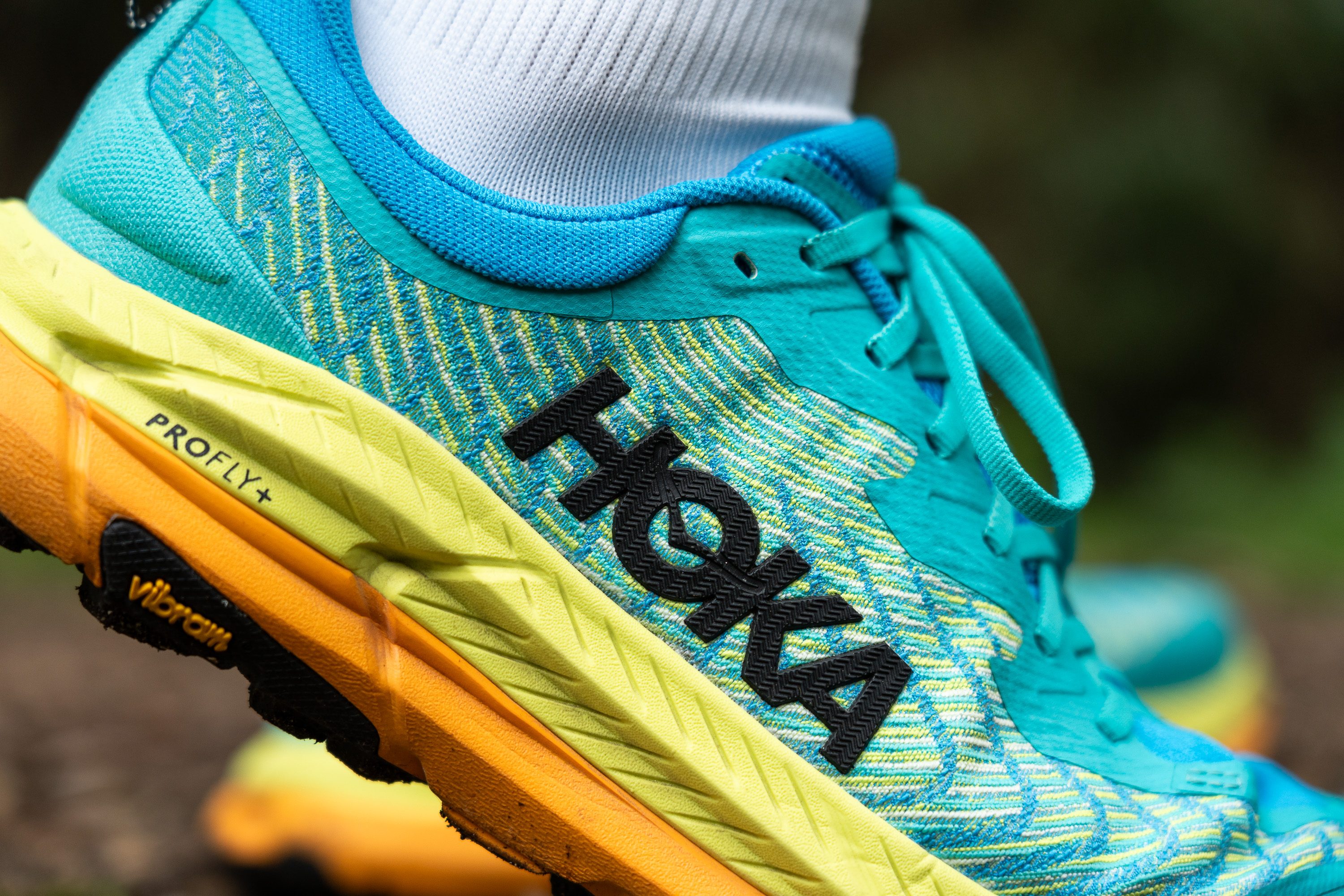
Standing tall at 38.0 mm, if you're in search of a cushioned trail shoe, your search ends with the Mafate Speed 4. This shoe boasts a generous amount of foam underfoot, making it an excellent option for heel strikers who need ample cushioning.
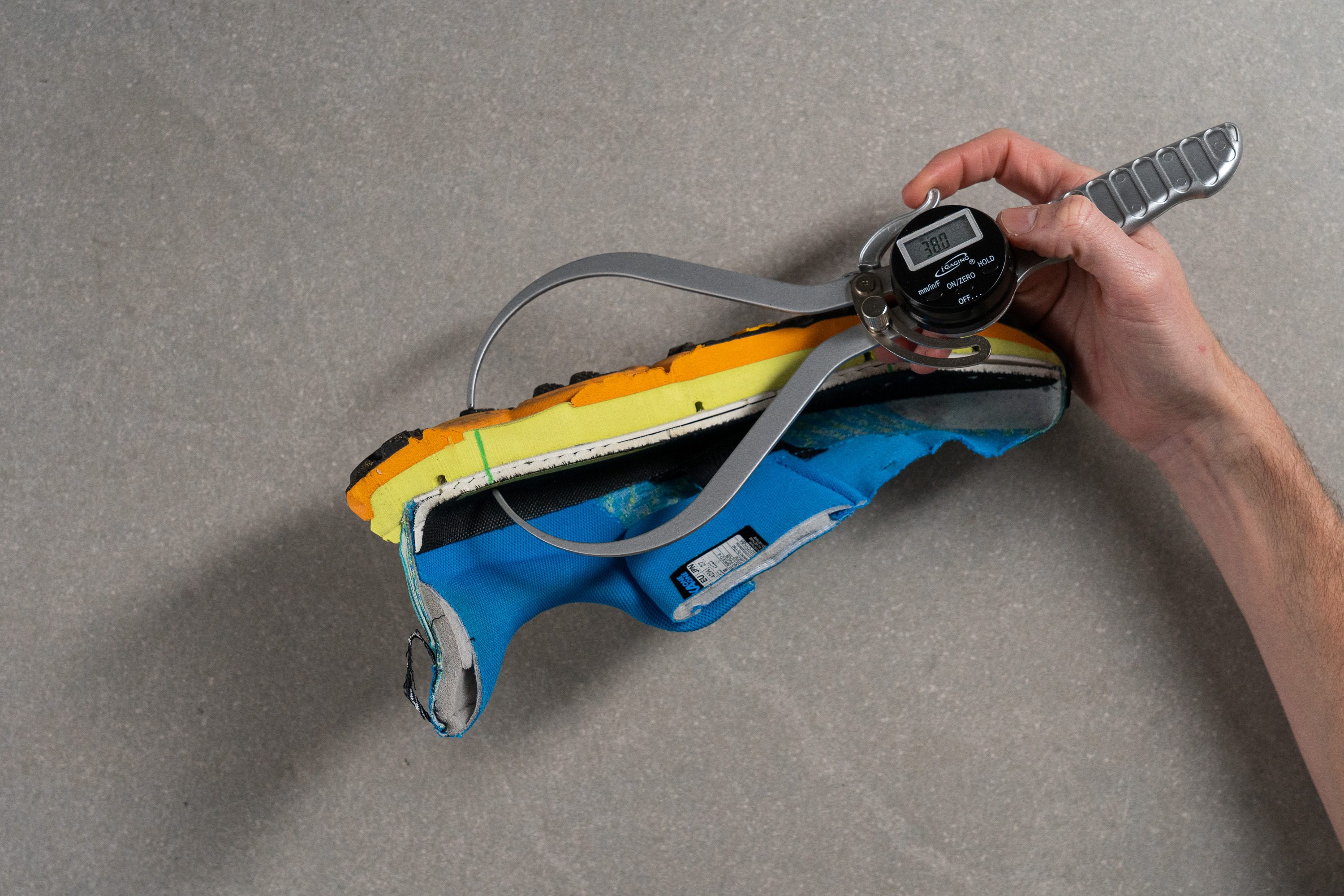
| Hoka Mafate Speed 4 | 38.0 mm |
| Average | 32.6 mm |
Forefoot stack
The forefoot also exceeds the 30-mm mark, measuring at 30.8 mm. This means that ground feel probably won't be present in this shoe, even for forefoot strikers.
This is also why Hoka chose to omit a rock plate in this shoe—there's enough foam to provide sufficient foot protection.
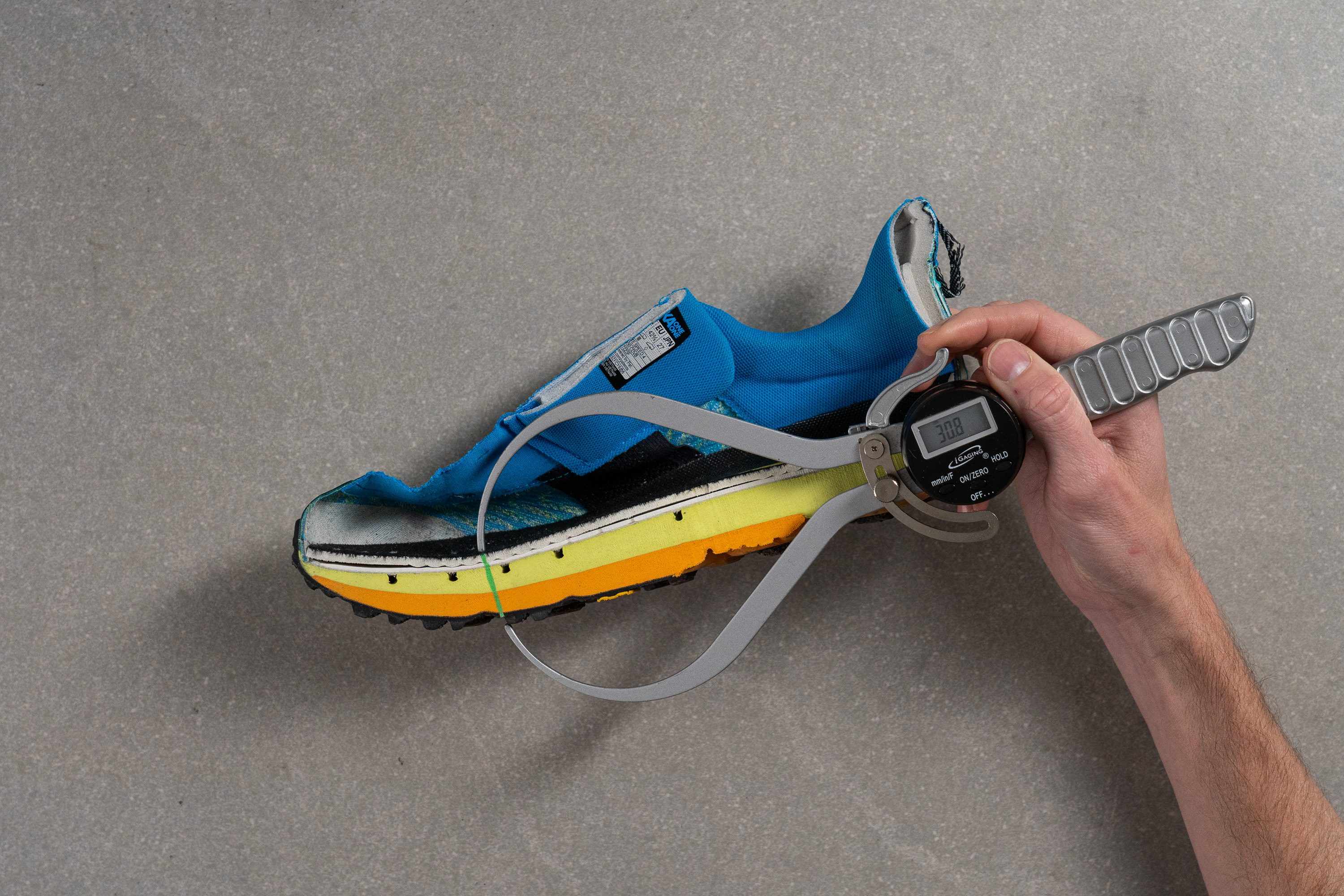
| Hoka Mafate Speed 4 | 30.8 mm |
| Average | 25.1 mm |
Drop
By subtracting the forefoot measurement from the heel, we got a real 7.2-mm heel-to-toe drop.
While most Hokas feature low-drop geometries, we're pleased with this number for the Mafate. It successfully caters to a broad spectrum of runners, accommodating all footstrikes in one shoe.
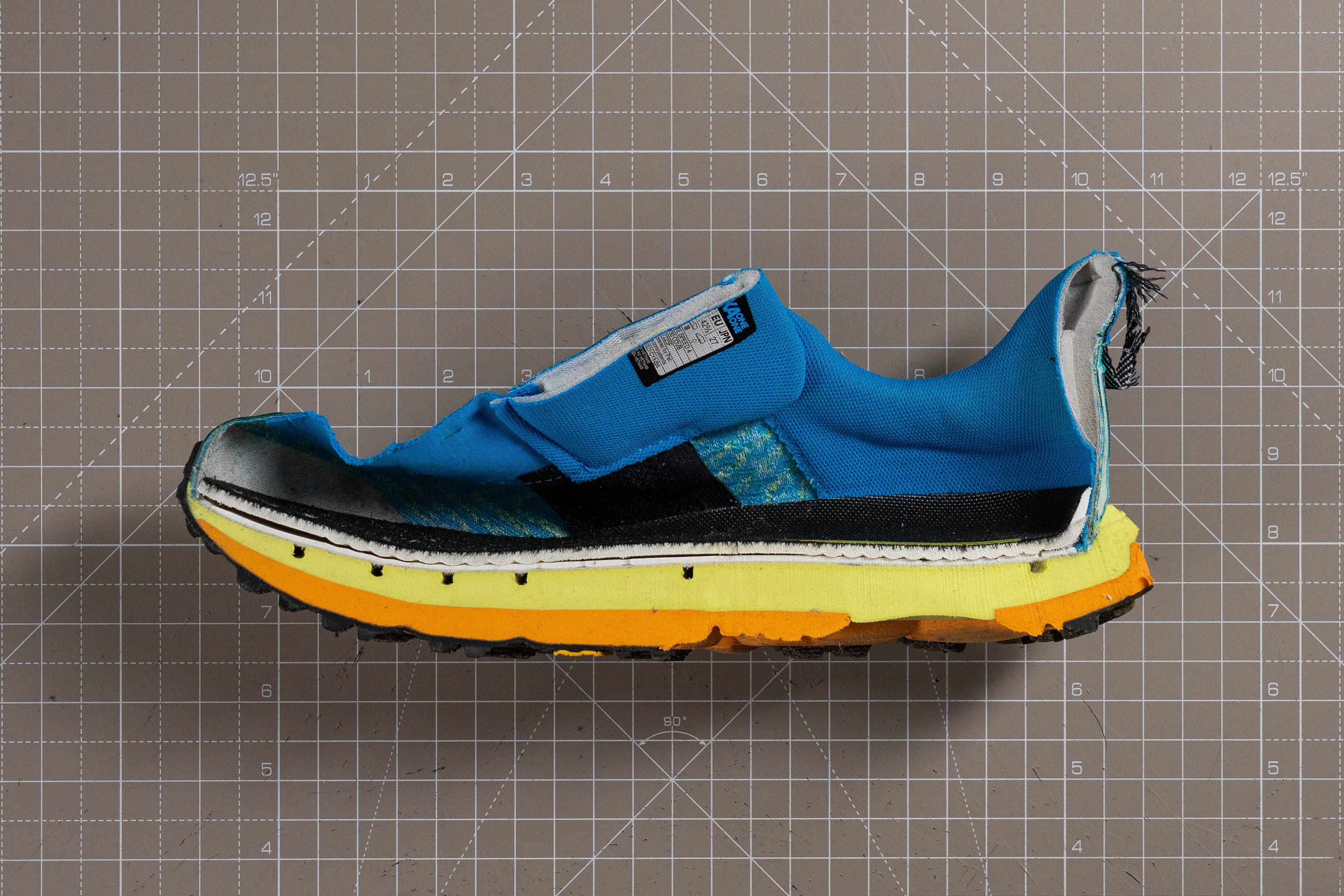
| Hoka Mafate Speed 4 | 7.2 mm |
| Average | 7.5 mm |
Midsole softness
Shifting our focus to the ProFly+ midsole, we anticipated the classic plush feel characteristic of Hoka, and we found some of it.
The primary foam, located closer to the foot, measured at 17.5 HA, providing that distinct softness underfoot. And this sensation is further enhanced by the thin insole.
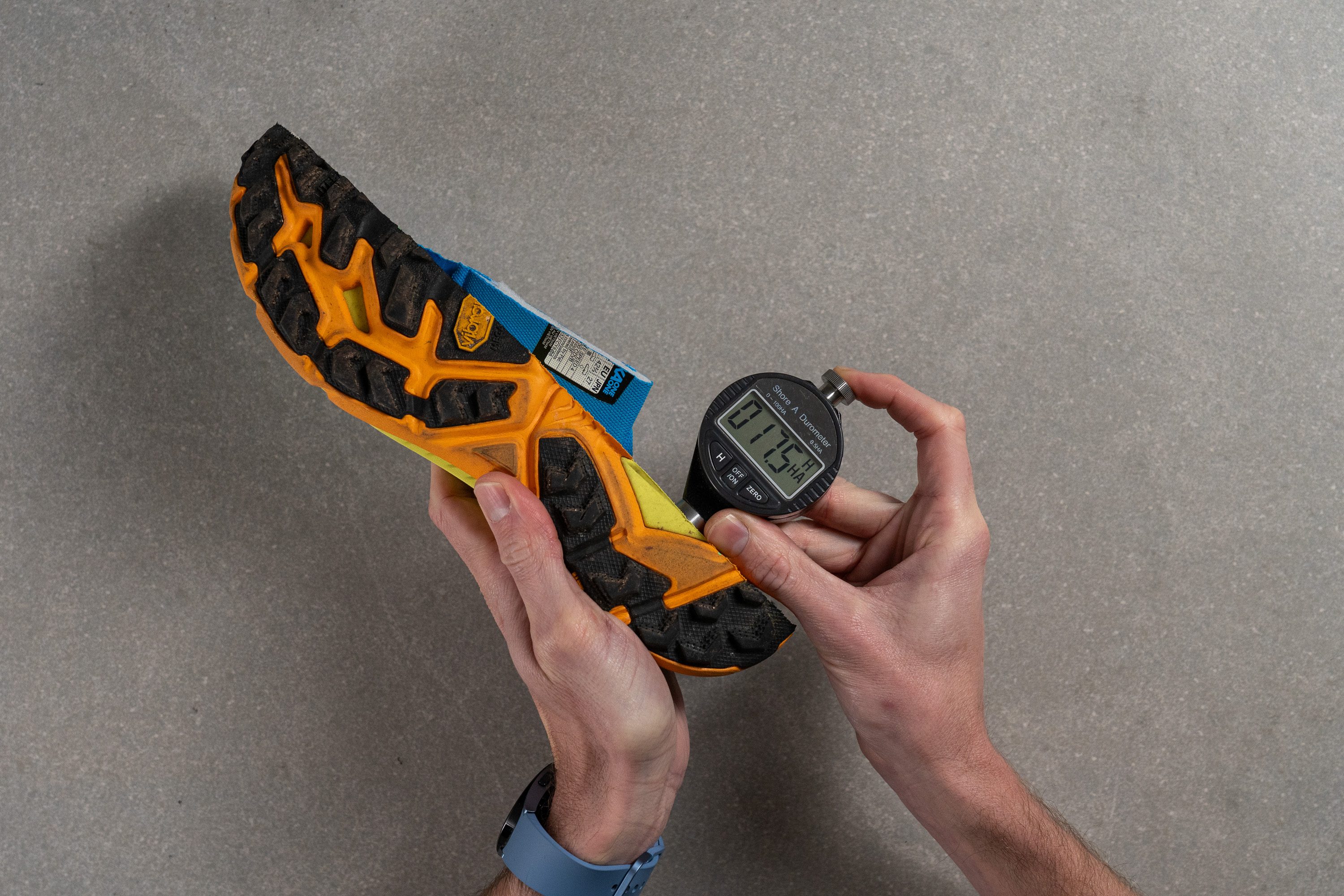
| Hoka Mafate Speed 4 | 17.5 HA |
| Average | 21.9 HA |
Secondary foam softness
Like many Hoka models nowadays, the Mafate Speed 4 boasts a dual-density midsole. In this case, the denser, notably-firmer foam is placed closer to the ground, enhancing stability.

We measured this secondary foam at 28.0 HA, which is quite firm and definitely noticeable while running.
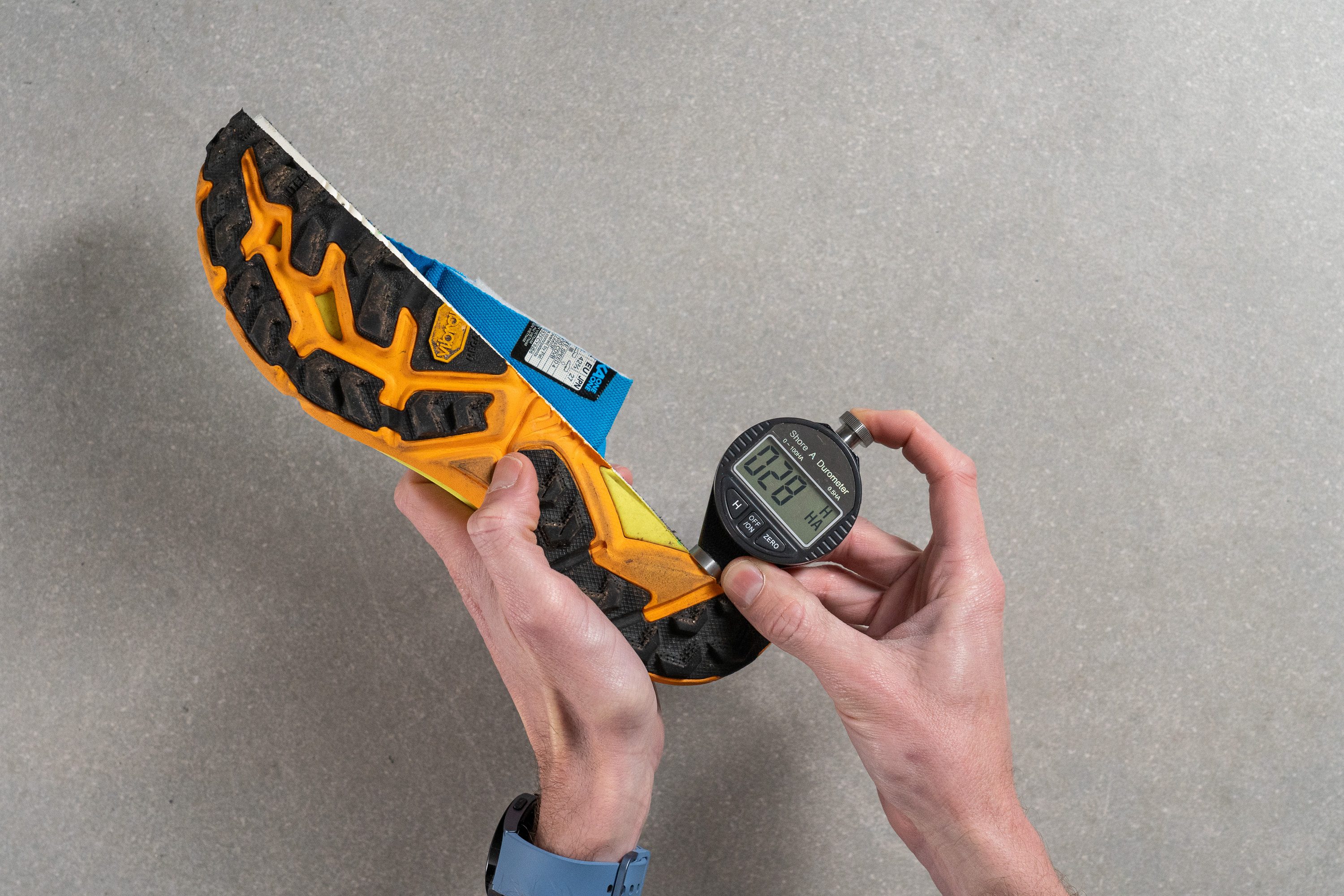
| Hoka Mafate Speed 4 | 28.0 HA |
| Average | 25.3 HA |
Size and fit
Size
Hoka Mafate Speed 4 fits true to size (85 votes).
Width / Fit
Hoka often designs narrow, snug-fitting toeboxes, and the Mafate Speed 4 stays true to this trend, though we found it’s more democratic than many of the brand's other models, like the Clifton 9.
We created a gel mold of the shoe's interiors and measured its widest part at 95.8 mm. This design comfortably accommodates most runners, although we felt some pressure in the toes...
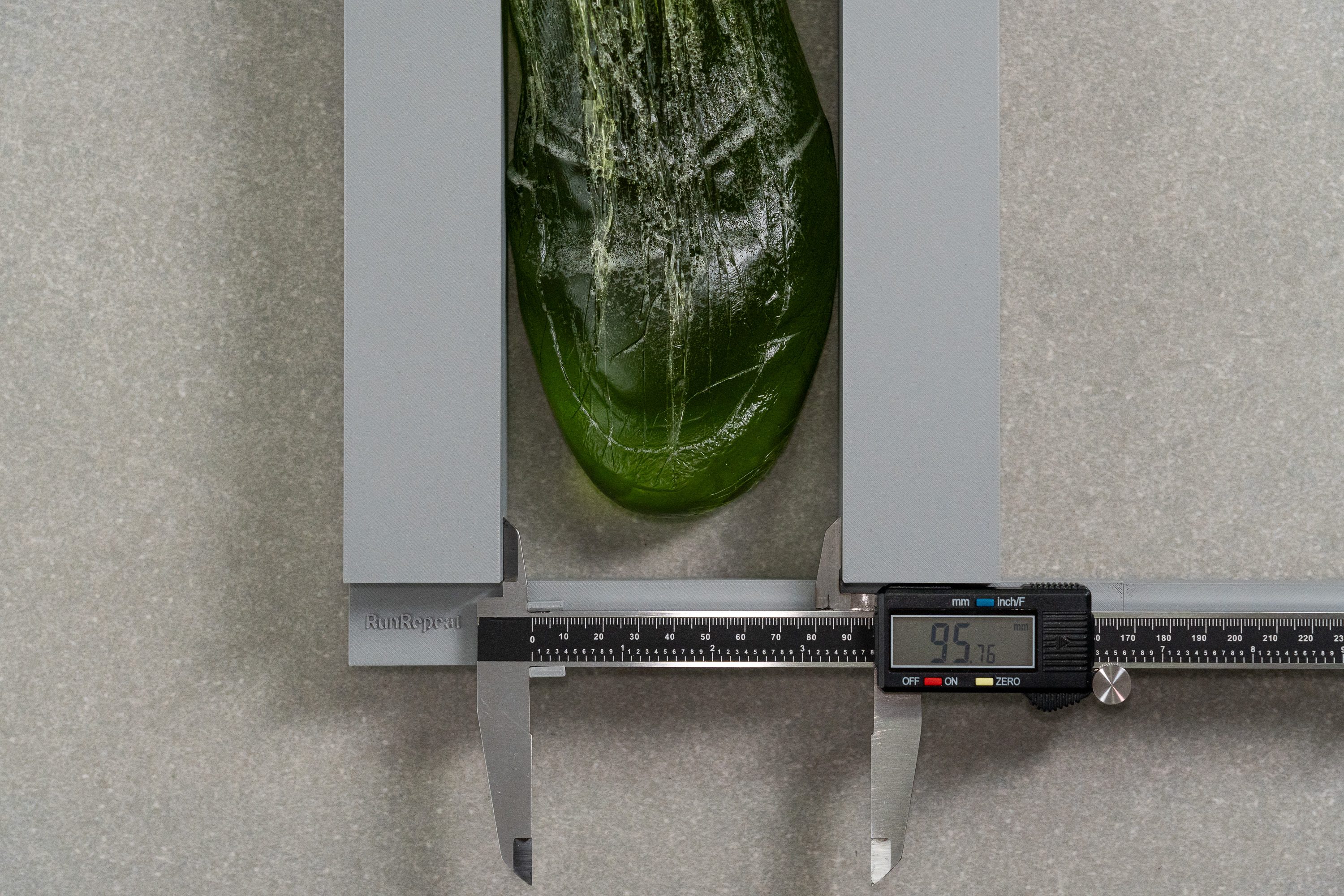
| Hoka Mafate Speed 4 | 95.8 mm |
| Average | 95.6 mm |
Toebox width
Thanks to our multi-measurement method, we discovered the truth about this toebox—it’s ultra-tapered!
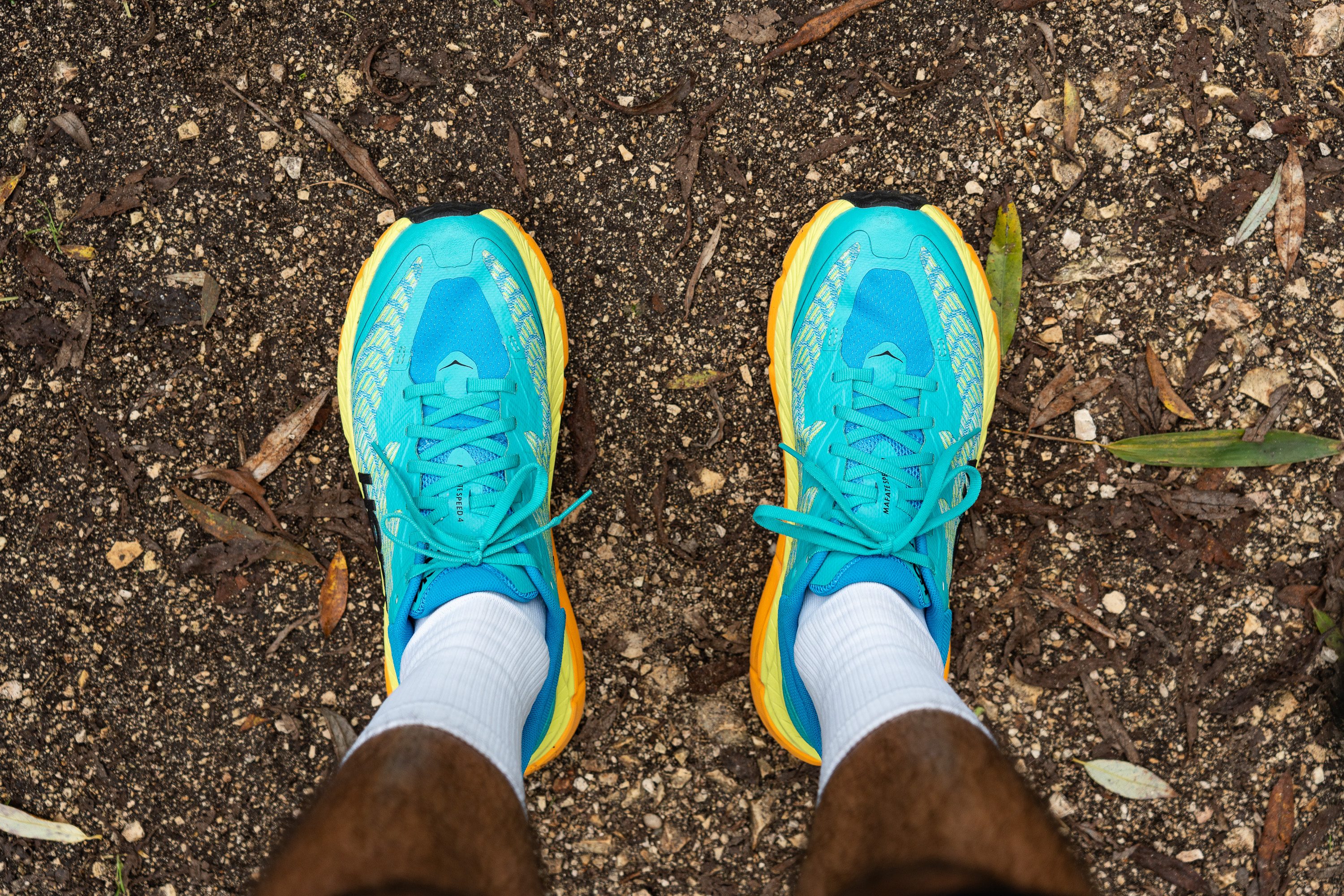
At 69.8 mm, it’s one of the few shoes in the lab to dip below the 70-mm threshold, creating a pointy toebox that we think won’t suit runners with wide feet.
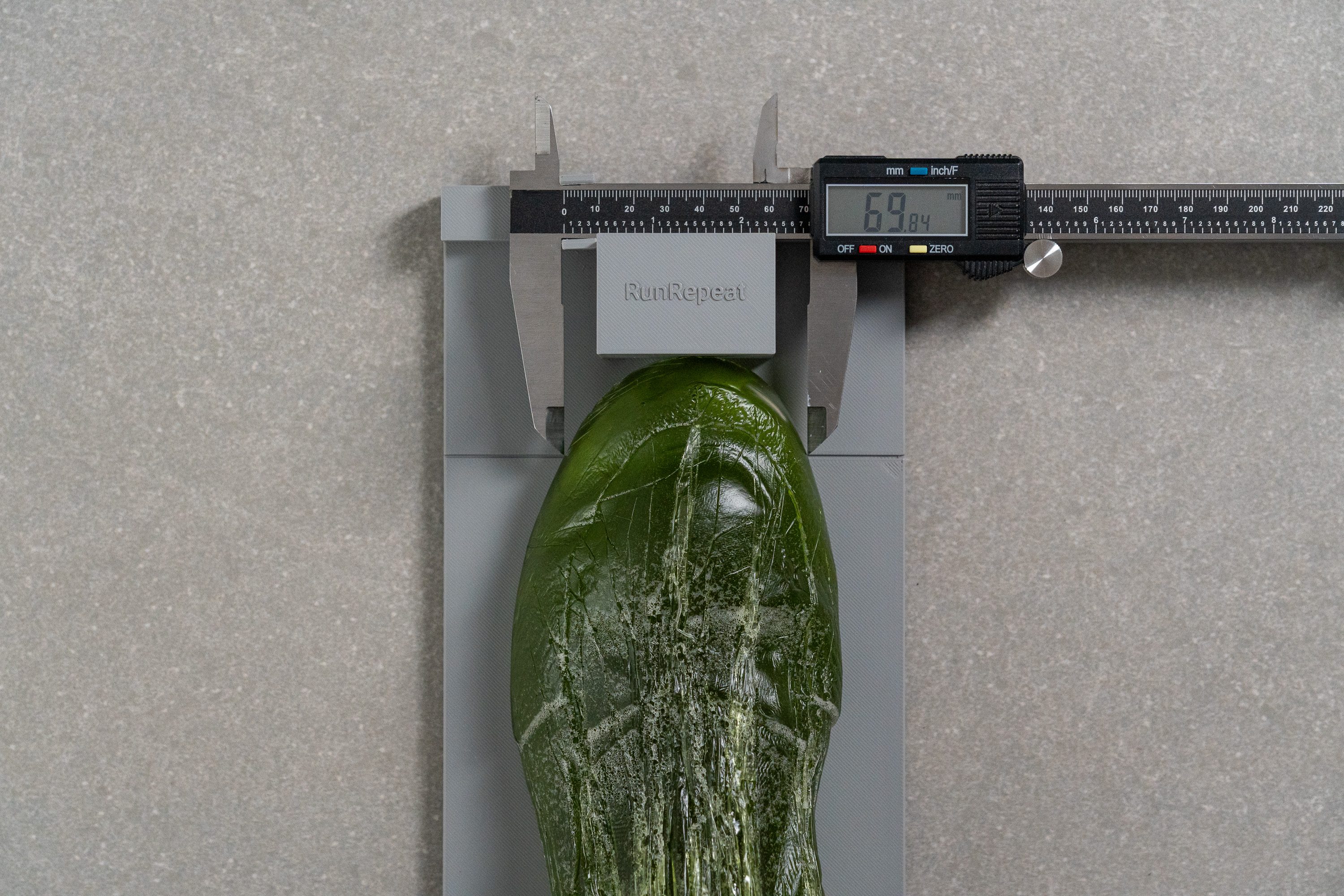
| Hoka Mafate Speed 4 | 69.8 mm |
| Average | 74.6 mm |
Toebox height
The toebox sits slightly low on the toes but never caused us any issues. At 26.2 mm, it offers an outcome that balances a snug-fit, performance-driven design with a decent level of comfort.
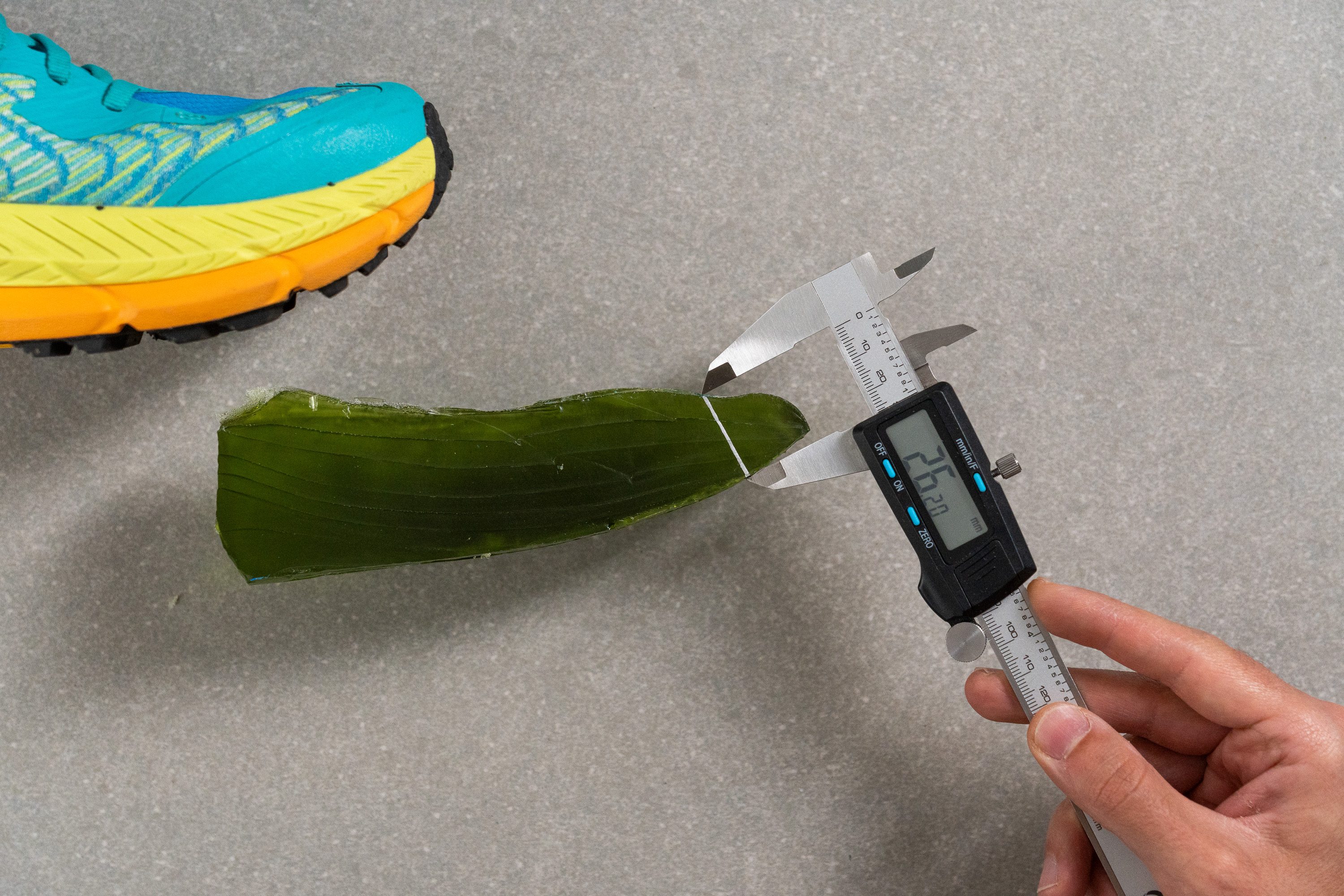
| Hoka Mafate Speed 4 | 26.2 mm |
| Average | 27.1 mm |
Traction / Grip
Lug depth
The Mafate Speed 4 is specifically designed for technical and loose terrains, which explains the 4 mm lugs on its outsole. Anything shorter would compromise the shoe's intended purpose.
For less demanding trails, Hoka offers alternatives like the Speedgoat 5, which features shorter, 3-mm lugs.
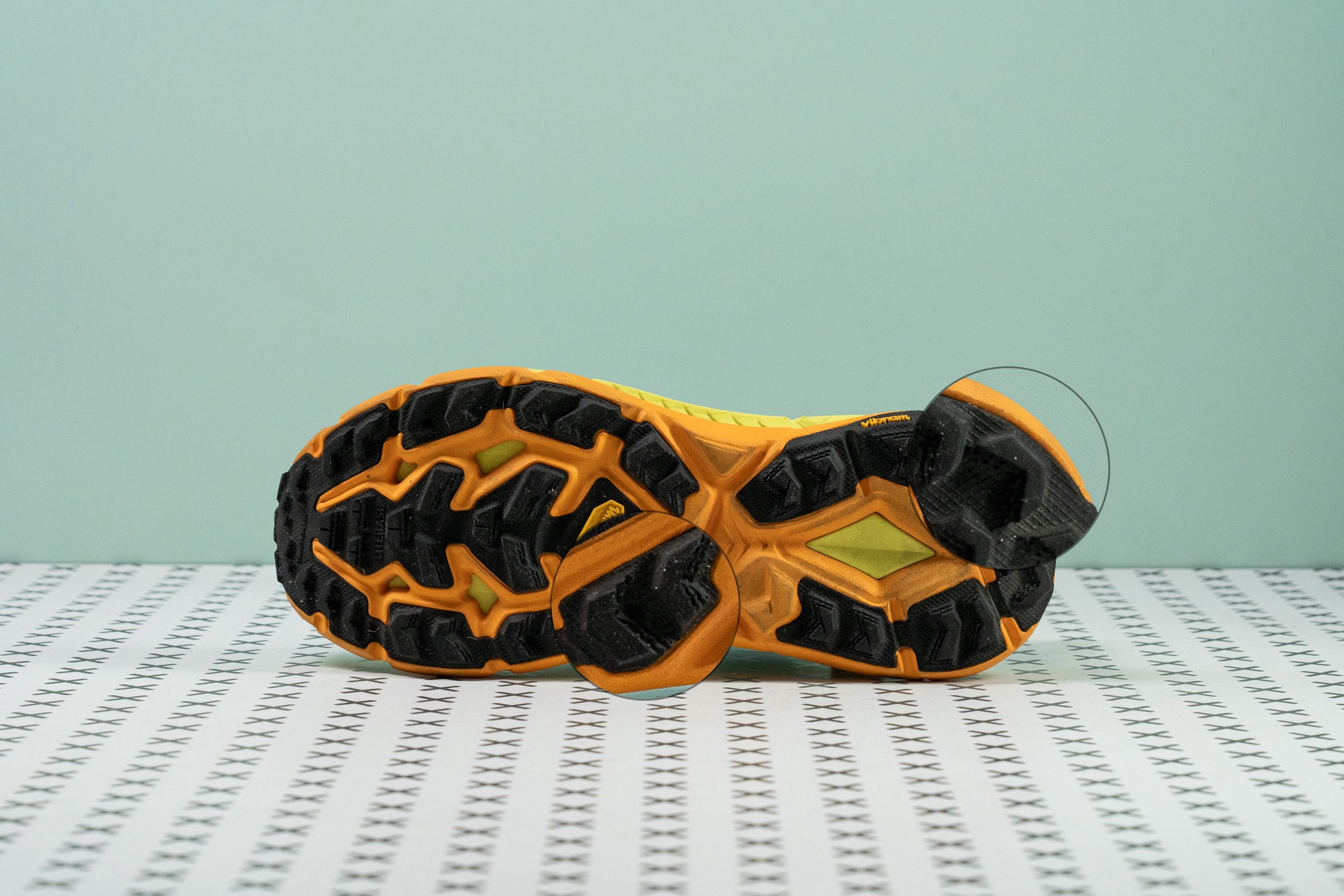
Equally noteworthy is the variety in the shapes and textures of the Hoka's Traction Lugs. We observed a dominance of chevron-style shapes in the heel and sides for enhanced traction on both downhills and uphills, complemented by rectangular lugs in the center of the forefoot.
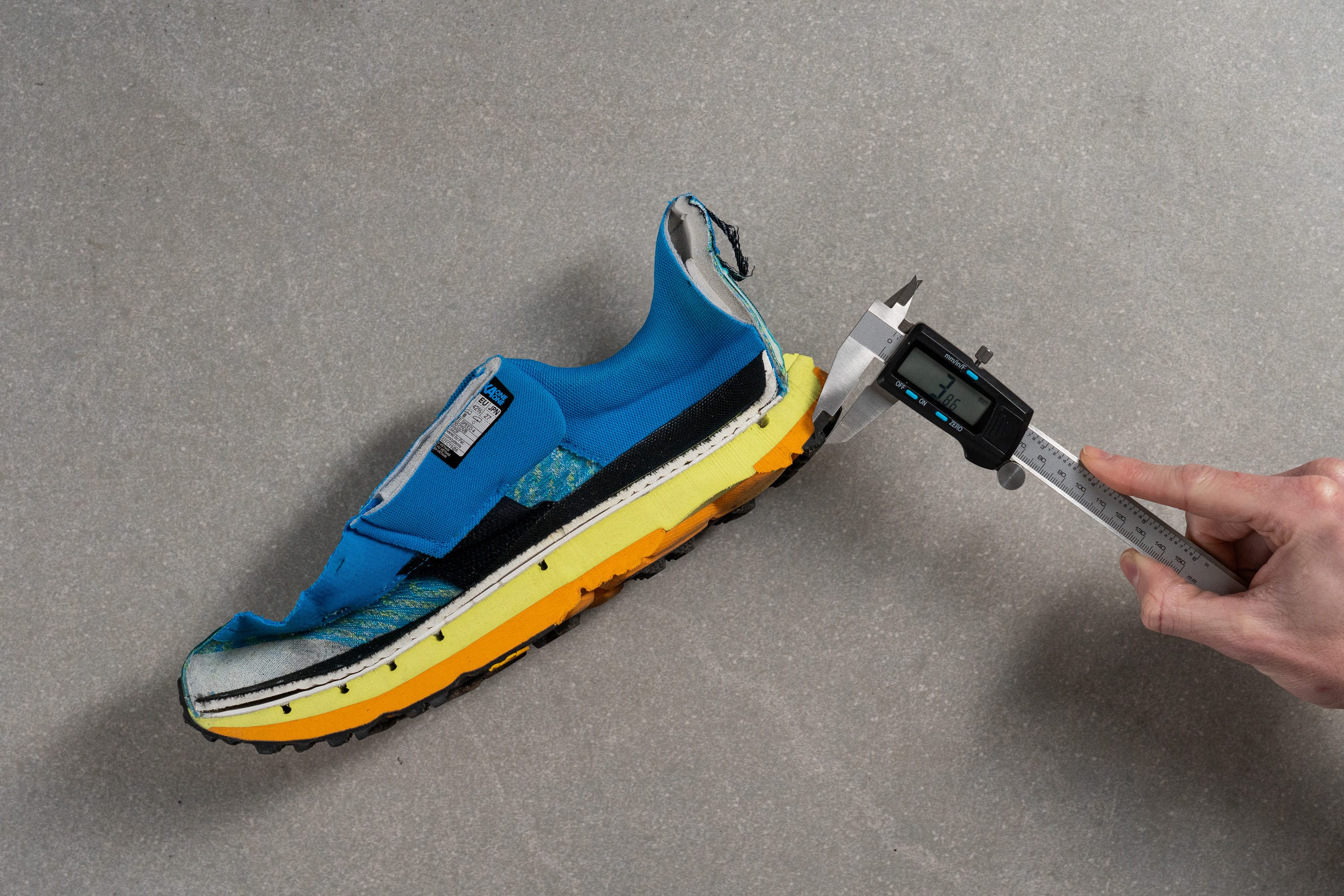
| Hoka Mafate Speed 4 | 3.9 mm |
| Average | 3.5 mm |
Outsole design
The HOKA Mafate Speed 4 features a full-length Vibram Megagrip outsole with aggressive, multi-directional lugs arranged across the entire surface. The rubber is segmented by a series of deep grooves and a big heel cutout that reduces weight without taking much grip away. Its rugged design and good rubber coverage reflect a build optimized for technical trail usage.
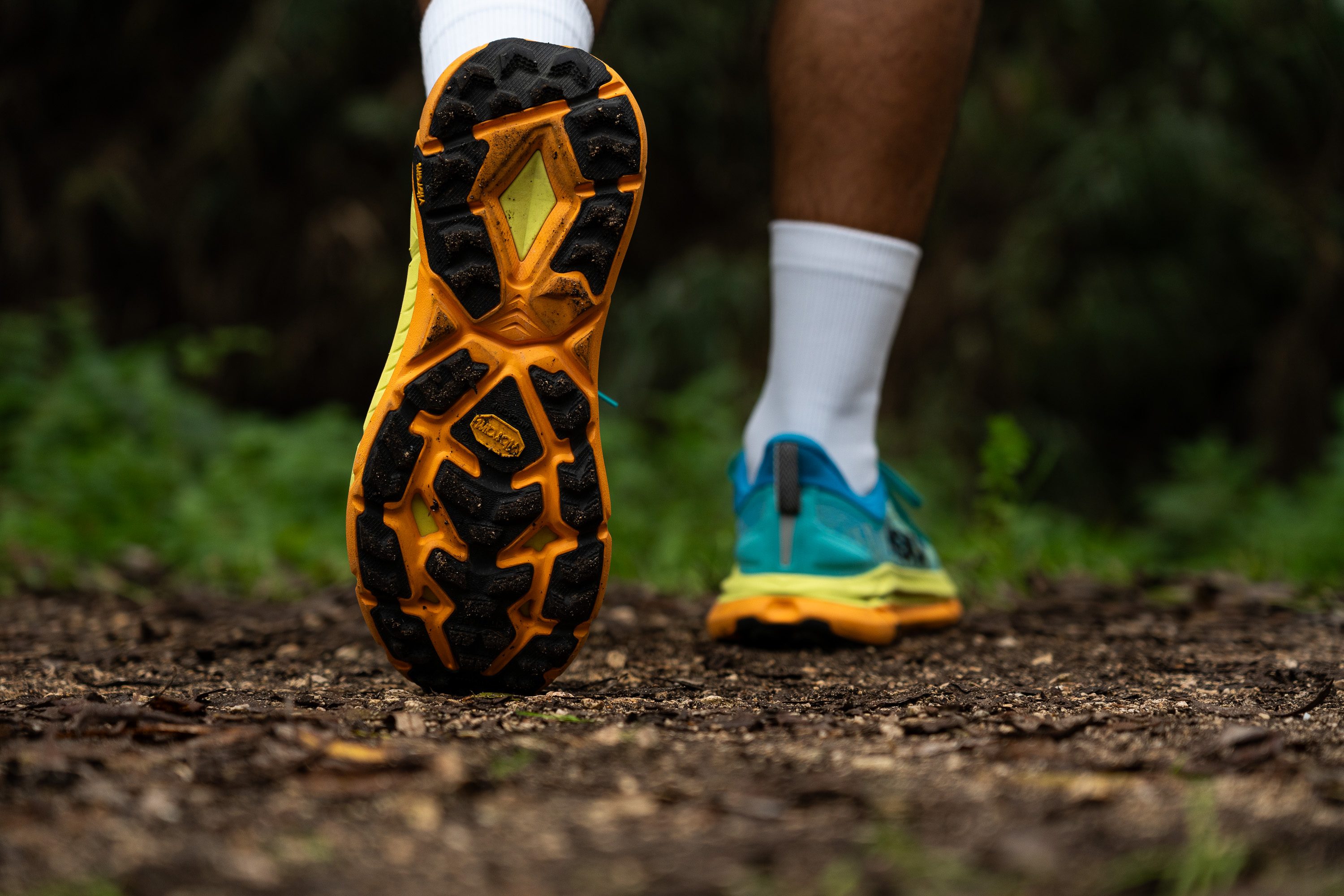
Flexibility / Stiffness
While the Mafate Speed 4 is quite stiff torsionally, it's much more flexible longitudinally, which is a feature we appreciated. This flexibility makes it suitable for walking or hiking.
In our 30-degree bend test, we only needed to apply 14.1N of force.
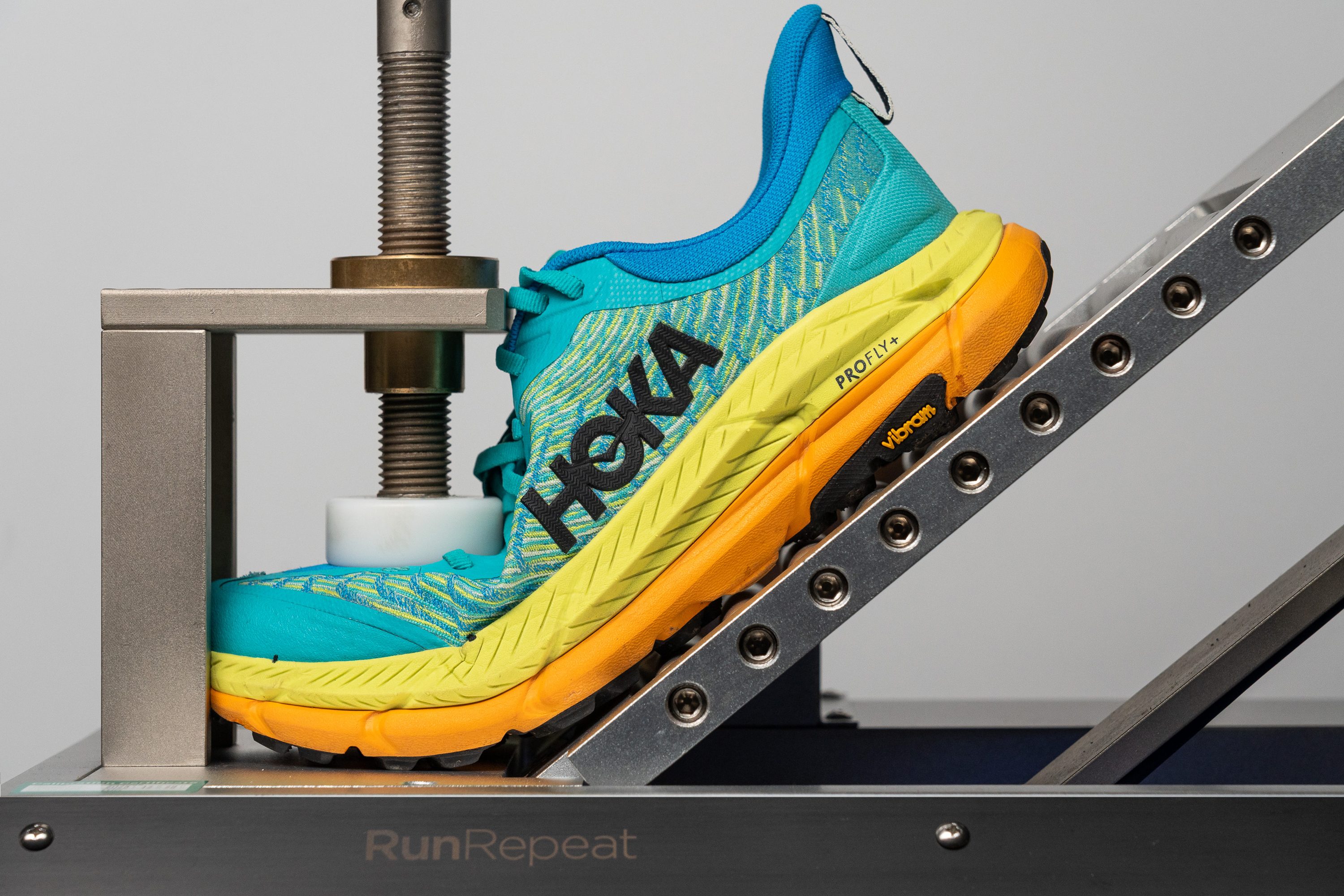
| Hoka Mafate Speed 4 | 14.1N |
| Average | 14.7N |
Stiffness in cold
After placing the shoe in the freezer again to simulate cold conditions, we repeated the stiffness test. The force required this time increased to 31.8N.
| Hoka Mafate Speed 4 | 31.8N |
| Average | 35.9N |
Weight
The Mafate Speed 4 is designed as a cushioned trail shoe, which naturally means it can't be as ultra-lightweight as the featherlike Hoka Zinal 2.
Yet, it doesn't feel heavy and just slightly exceeds the 10-oz mark, weighing in at 10.3 oz (293g). This is a good result, especially considering its huge stack height.

| Hoka Mafate Speed 4 | 10.3 oz (293g) |
| Average | 10.2 oz (289g) |
Breathability
The upper of this Hoka doesn't immediately strike us as highly breathable, but we're here to test, not just speculate. So we hooked up our smoke-pumping machine to the Mafate Speed 4 to assess its actual breathability.
Our testing led us to a score of 3 out of 5, which is average but respectable for a trail shoe. Remember that excessive airflow can compromise comfort in colder conditions, which is when these shoes are often used.
Shining a light through the upper revealed Hoka's design strategy. The shoe has a base layer of thin mesh, with large overlays across the instep and added midfoot reinforcement for stability—factors contributing to its average breathability score.
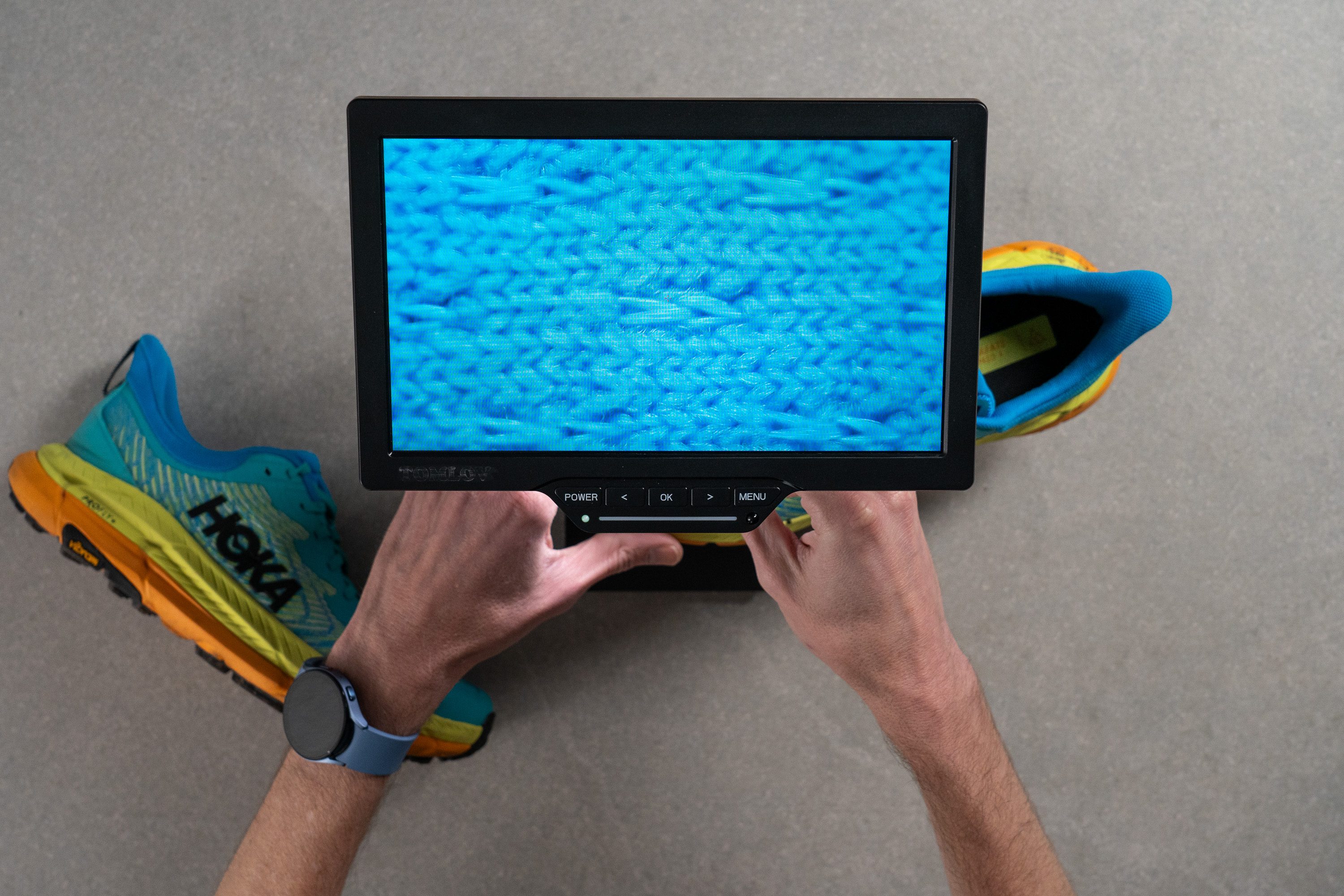
Under the microscope, we found that Hoka opted for an engineered mesh without ventilation holes, clearly prioritizing durability above all.

The upper offers some flexibility and decent padding, concealing all stitches under fabric for enhanced comfort.
We were impressed with its performance and achieving a 3 out of 5 without any ventilation holes is commendable.
| Hoka Mafate Speed 4 | 3 |
| Average | 3.2 |
Stability
Lateral stability test
We previously mentioned that certain aspects of the shoe are designed with stability in mind, and indeed, we experienced a reassuring sense of stability in the Mafate Speed 4, even while running downhill!
Torsional rigidity
A significant portion of this stability is due to the shoe's substantial torsional rigidity, which we rated 4 out of 5.
This limited flexibility can be attributed to the shoe's large midsole and the denser secondary foam.
| Hoka Mafate Speed 4 | 4 |
| Average | 3.6 |
Heel counter stiffness
However, we were quite surprised to discover a fairly flexible heel counter, which we rated only 2 out of 5.
This relatively low score might be due to the shoe's construction, as it extends high into the Achilles area for support. Therefore, it doesn't need excessive stiffness to stabilize that area and prevent heel slippage.
| Hoka Mafate Speed 4 | 2 |
| Average | 3 |
Midsole width - forefoot
In the forefoot, we measured 115.8 mm, which is slightly wider than the average shoe. This design is intentionally aimed at providing stability, especially for forefoot and midfoot strikers.
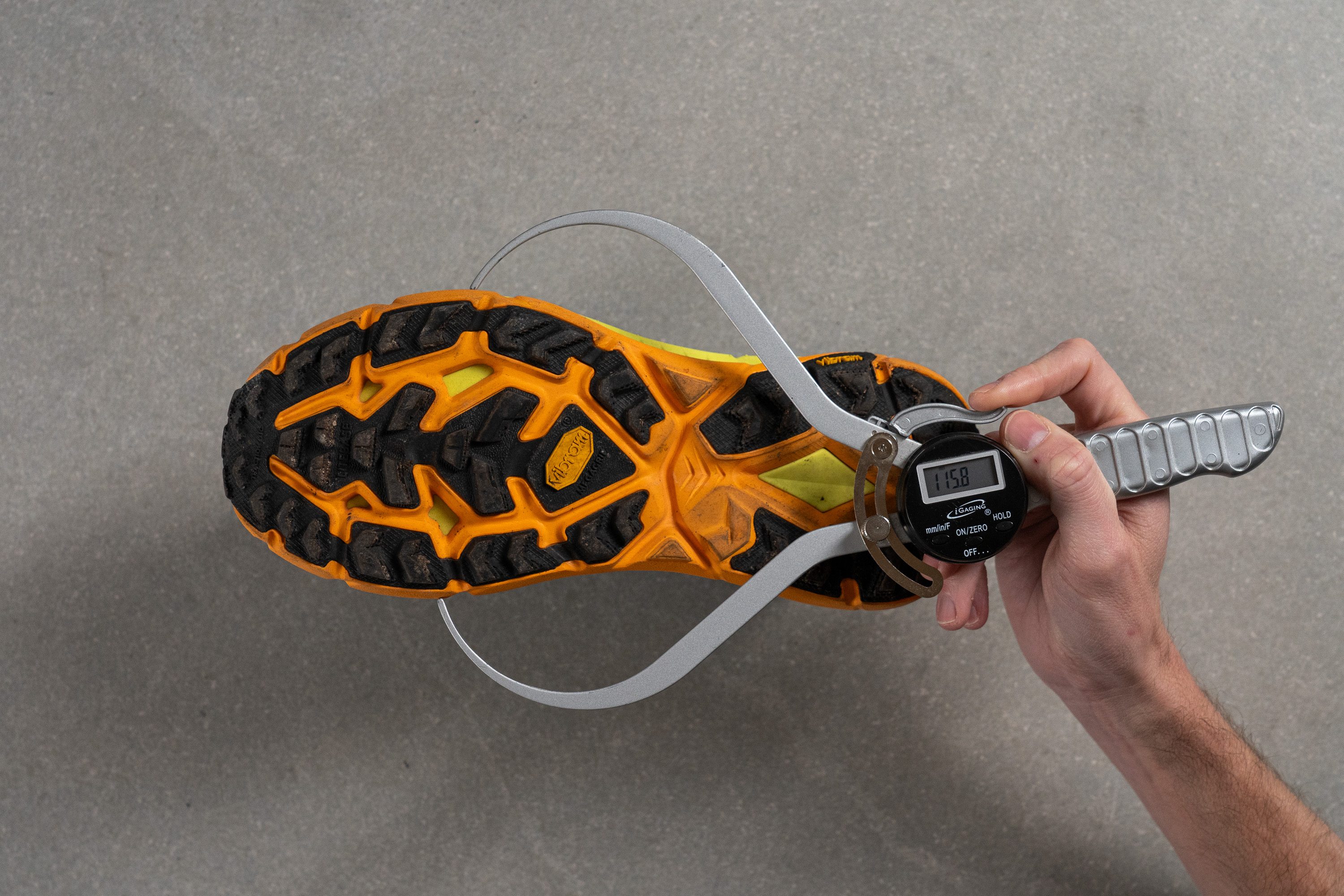
| Hoka Mafate Speed 4 | 115.8 mm |
| Average | 112.8 mm |
Midsole width - heel
Upon taking this measurement in the lab, we instantly understood why we felt so assured while running downhill.
With a massive width of 101.1 mm, the Mafate Speed 4 truly excels in heel landings, providing remarkable stability and confidence!
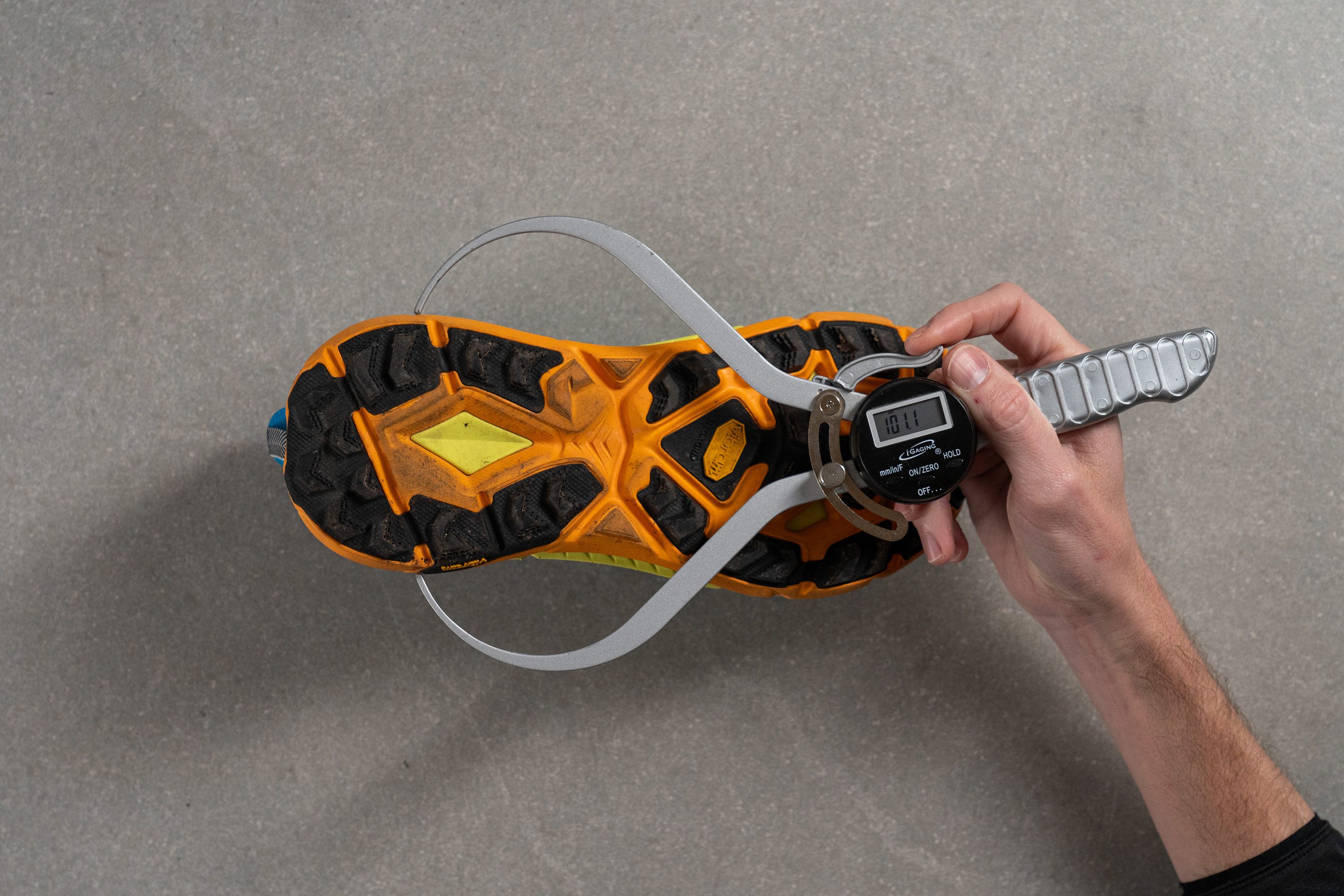
| Hoka Mafate Speed 4 | 101.1 mm |
| Average | 89.9 mm |
Durability
Toebox durability
Upon closely inspecting the shoe, we noticed that Hoka prioritized protecting the upper with multiple layers, even if it meant sacrificing a bit of airflow, as we previously observed.
This strategy proved fruitful. As evident in the comparison picture below against the UA Charged Assert 10, the Mafate 4 stands out impressively after the Dremel test. We awarded it a solid 4 out of 5 for its robust design and effective protection.
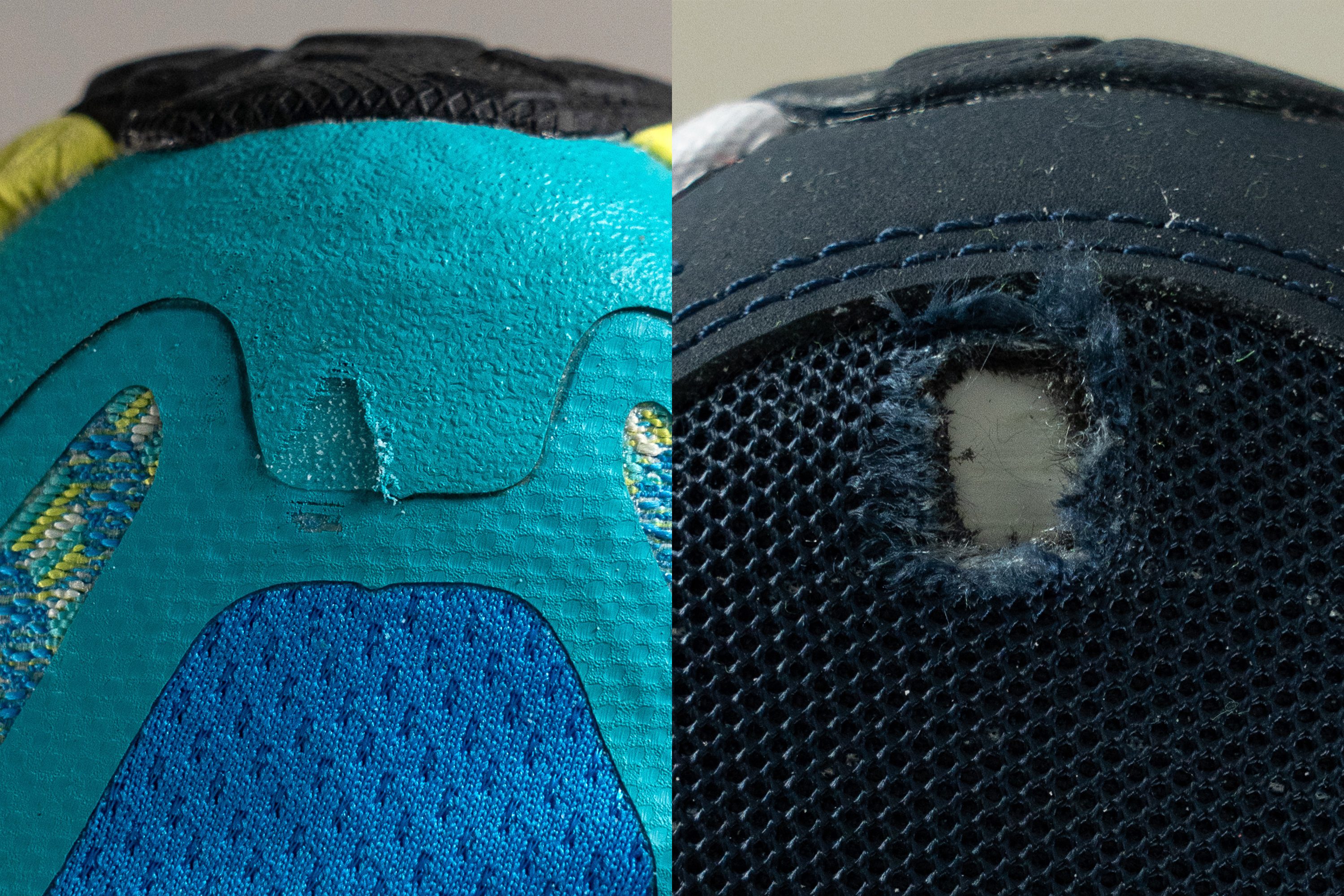
| Hoka Mafate Speed 4 | 4 |
| Average | 3.1 |
Heel padding durability
The heel padding of the Mafate Speed 4 performed exceptionally well in our Dremel test, which was a pleasant surprise.
Just a few days earlier, we had tested the Tecton X 2 in the lab, where it scored the lowest, a mere 1 out of 5. However, the Mafate Speed 4 impressively earned a 4 out of 5, a truly fantastic score!

| Hoka Mafate Speed 4 | 4 |
| Average | 3 |
Outsole durability
But there's always the question of whether it will provide sufficient durability.
Luckily, after our rigorous Dremel test in the lab, we observed only a 0.9-mm indentation, suggesting that the shoe won't face significant durability issues. However, we also believe it's not among the most durable outsoles on the trail running market.
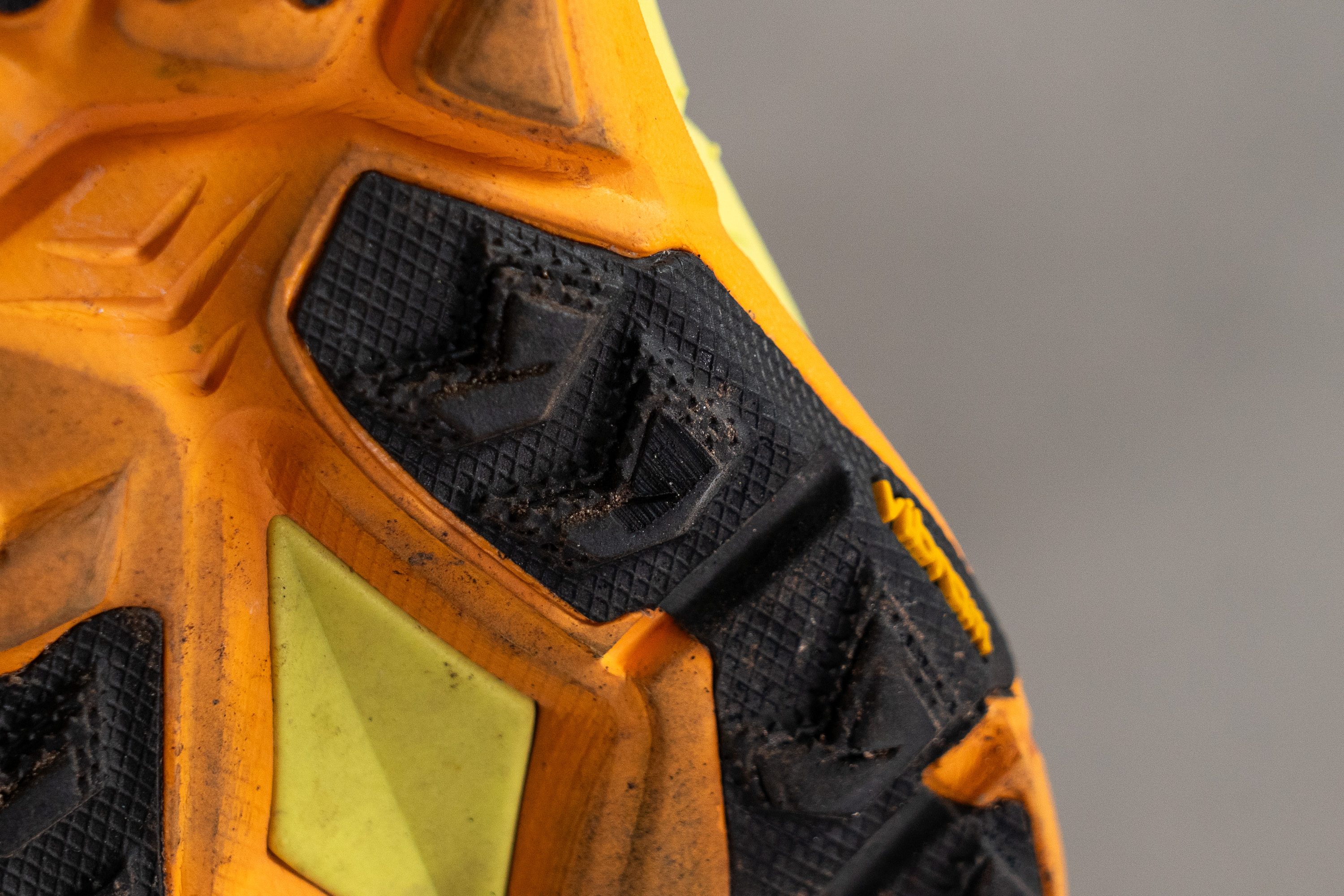
| Hoka Mafate Speed 4 | 0.9 mm |
| Average | 0.9 mm |
Outsole thickness
Wrapping up our discussion on the outsole for now, we measured its thickness at 2.1 mm. While some runners might favor a thicker outsole for added durability, we believe this thickness is a wise choice.
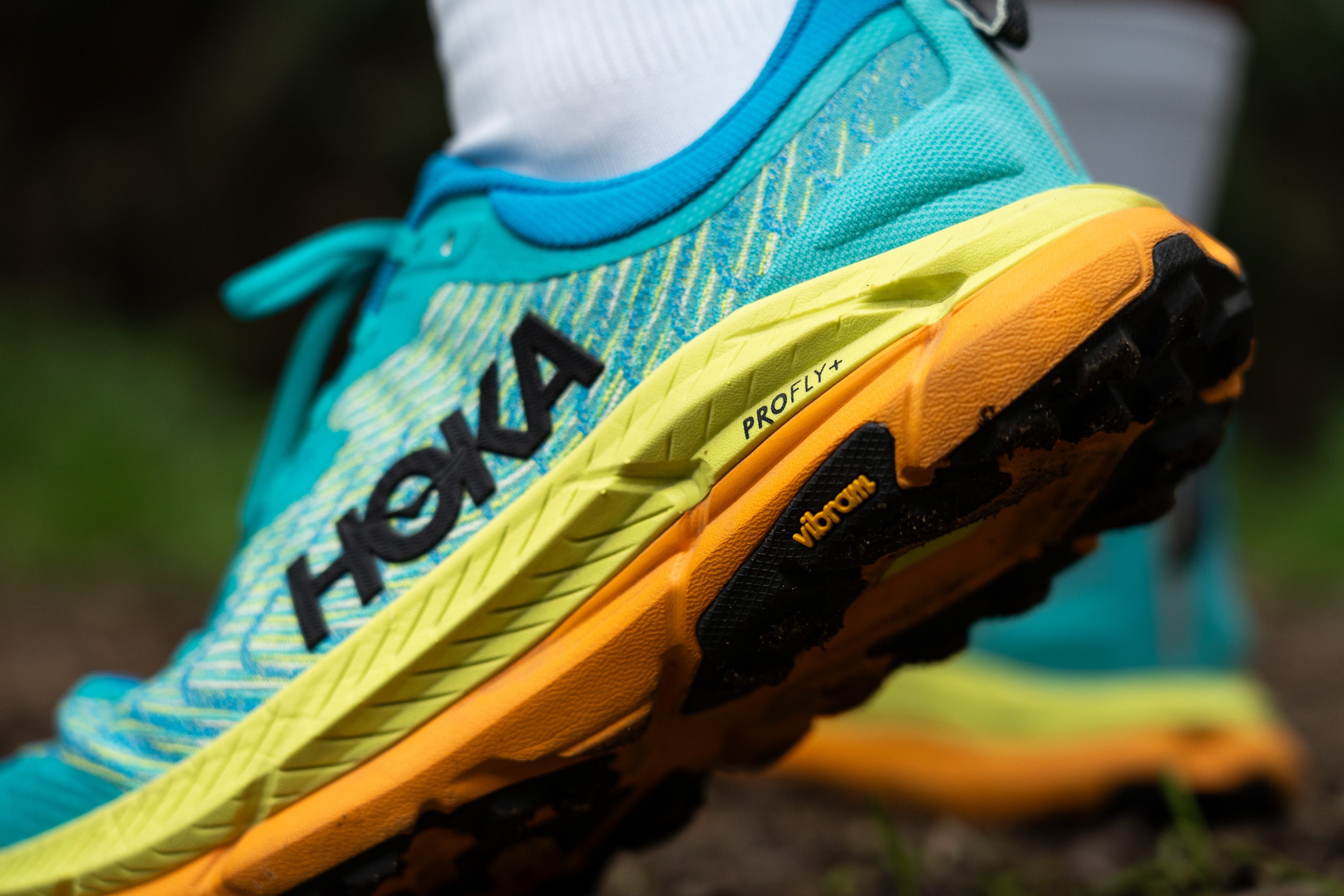
A thicker layer of rubber can mute the midsole's feel and create a firmer sensation underfoot while running, which isn't typically what Hoka aims to deliver.

| Hoka Mafate Speed 4 | 2.1 mm |
| Average | 2.2 mm |
Misc
Insole thickness
The insole is a bit thinner than usual at 3.3 mm, but it's not a cause for concern at all. Given the substantial amount of foam in the shoe, you're unlikely to notice the slight difference of a millimeter or two in the insole.
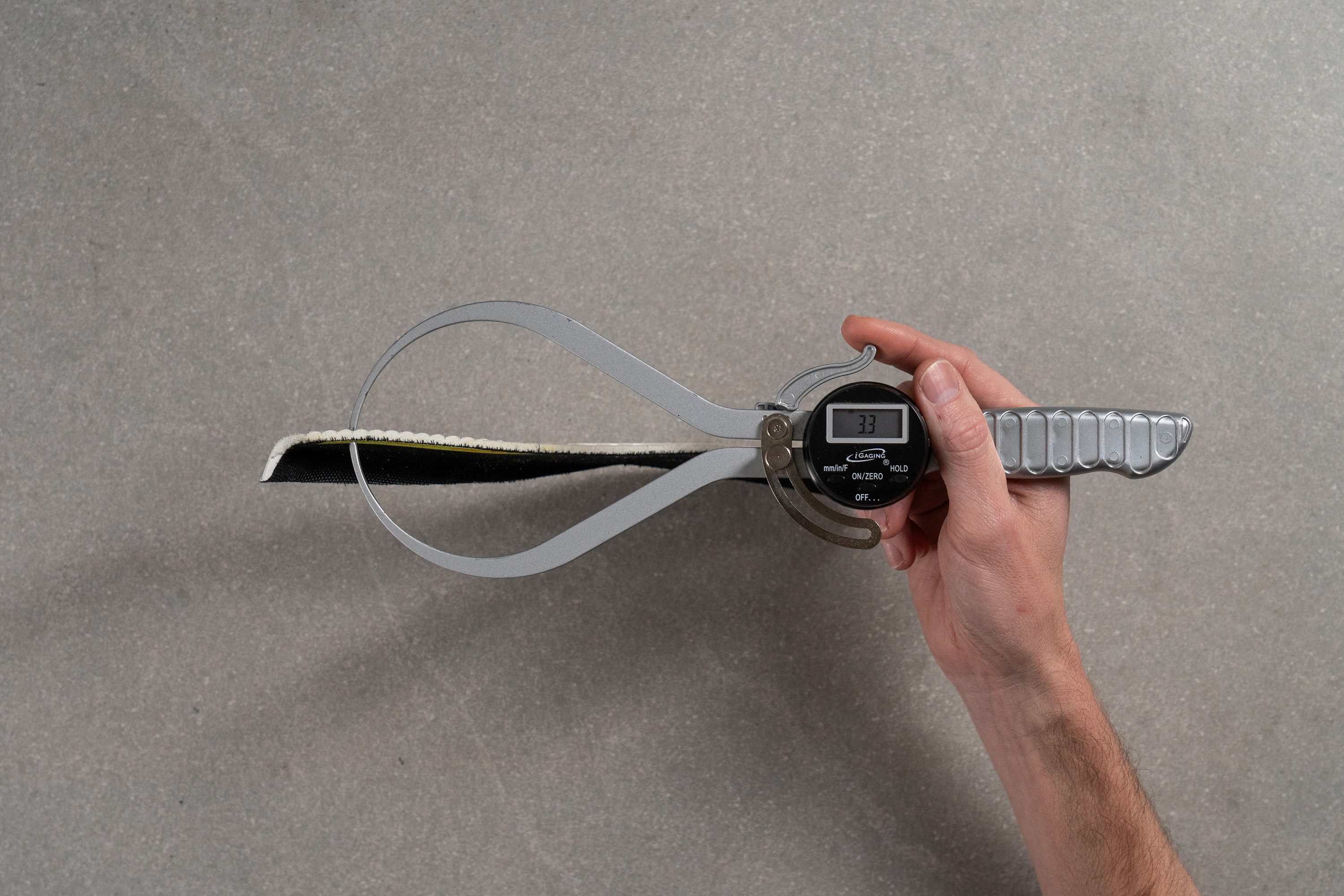
| Hoka Mafate Speed 4 | 3.3 mm |
| Average | 4.7 mm |
Removable insole
Removing the insole was hassle-free as it's not glued, but be wary that some OTC orthotics or insoles from other shoes might not fit well due to the shoe's narrow last.
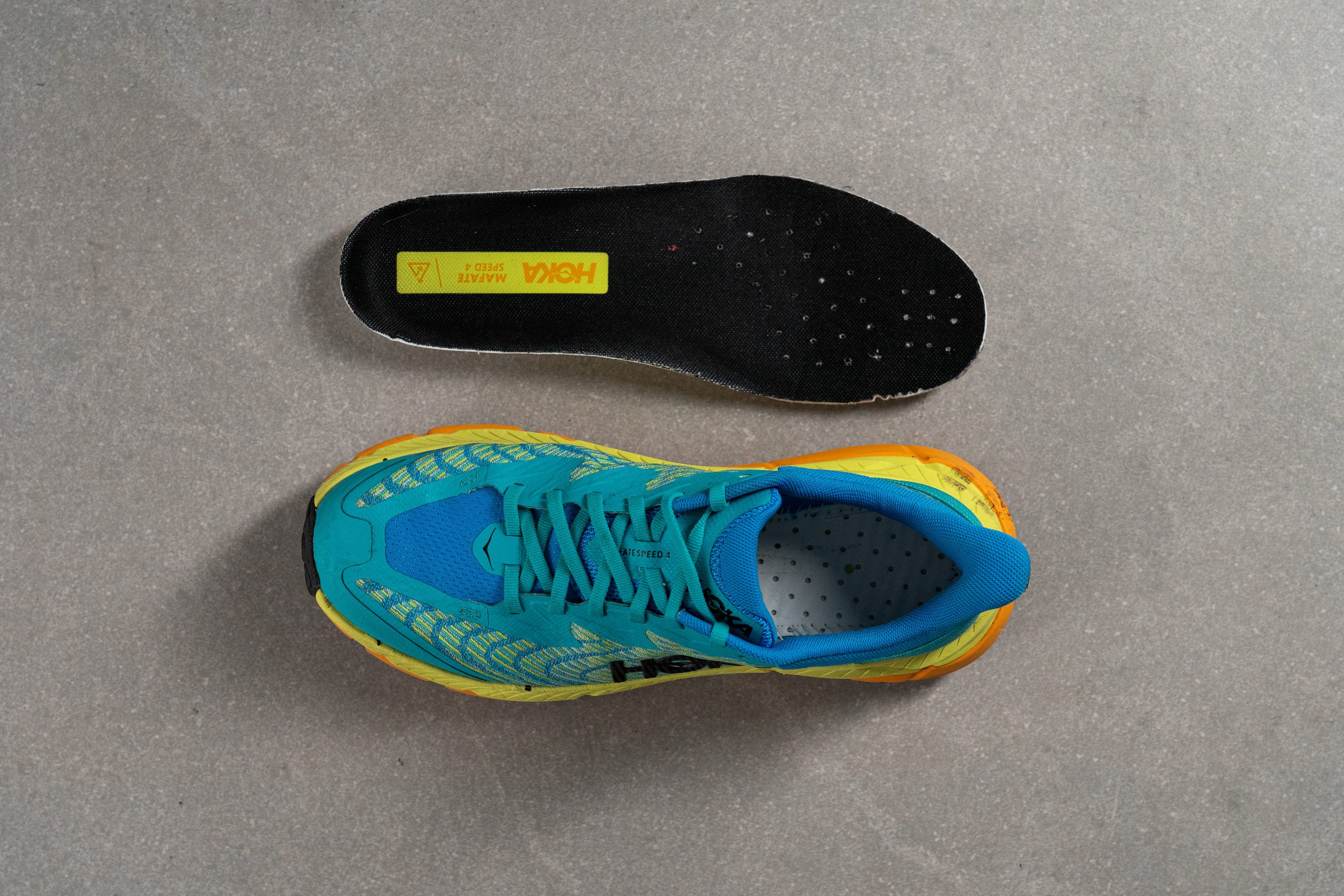
| Hoka Mafate Speed 4 | Yes |
Midsole softness in cold
When it gets colder, the midsole becomes a bit firmer, but the difference isn't drastic.
To determine the precise change, we put the shoe in the freezer for 20 minutes and then remeasured it. The new measurement came out to be 22.8 HA.
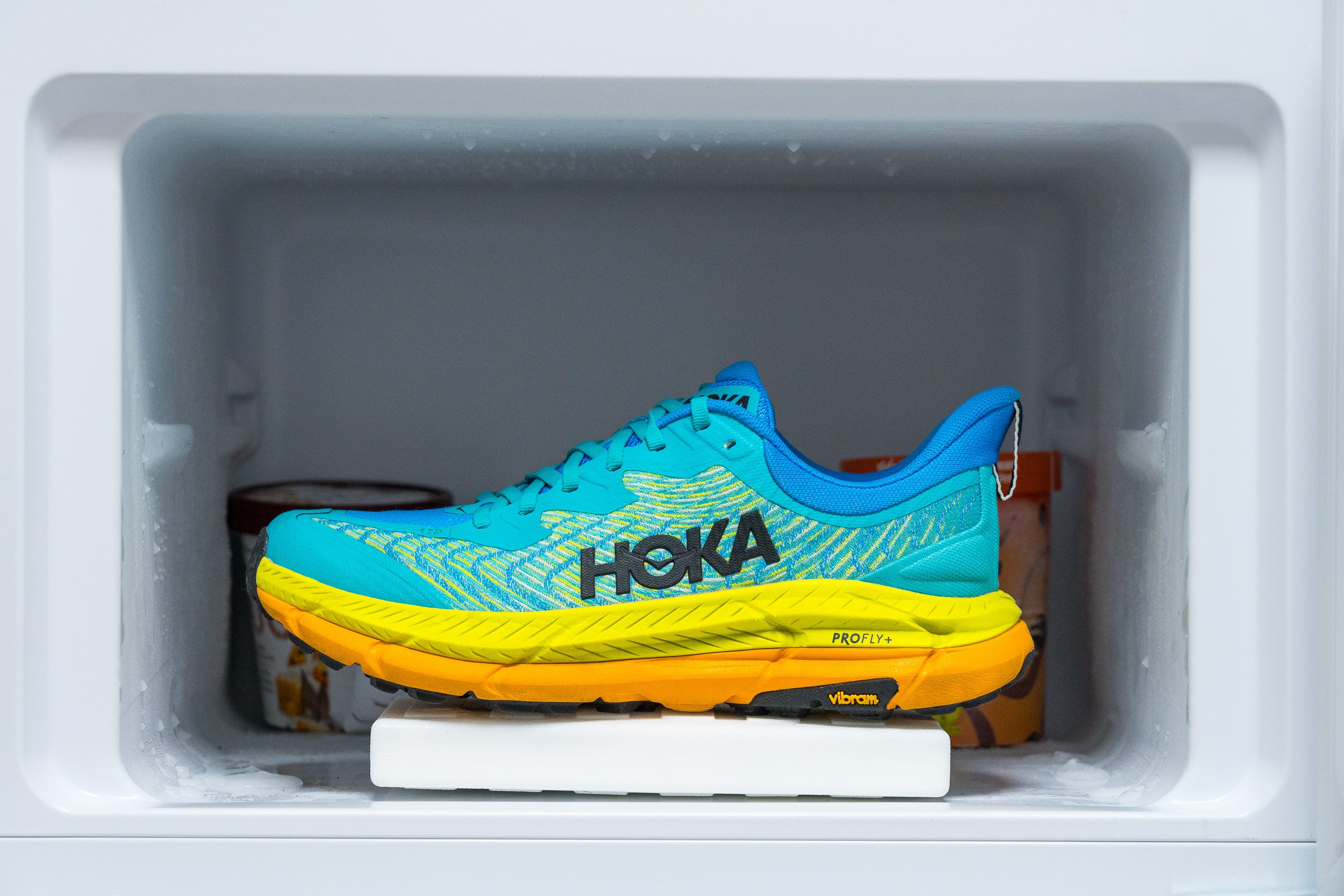
| Hoka Mafate Speed 4 | 22.8 HA |
| Average | 27.4 HA |
Midsole softness in cold (%)
The 30.3% difference aligns with the average, which didn't surprise us given the midsole's it's made with compression-molded EVA.
For a shoe priced close to $200, experiencing a more advanced superfoam, at least in the primary layer, would be a reasonable expectation.
| Hoka Mafate Speed 4 | 30% |
| Average | 26% |
Reflective elements
Here in the lab, we're big fans of reflective elements on trail running shoes. Luckily, the Mafate Speed 4 didn't disappoint us in this department!
| Hoka Mafate Speed 4 | Yes |
Tongue padding
The tongue is impressively padded at 7.5 mm, exceeding our expectations.
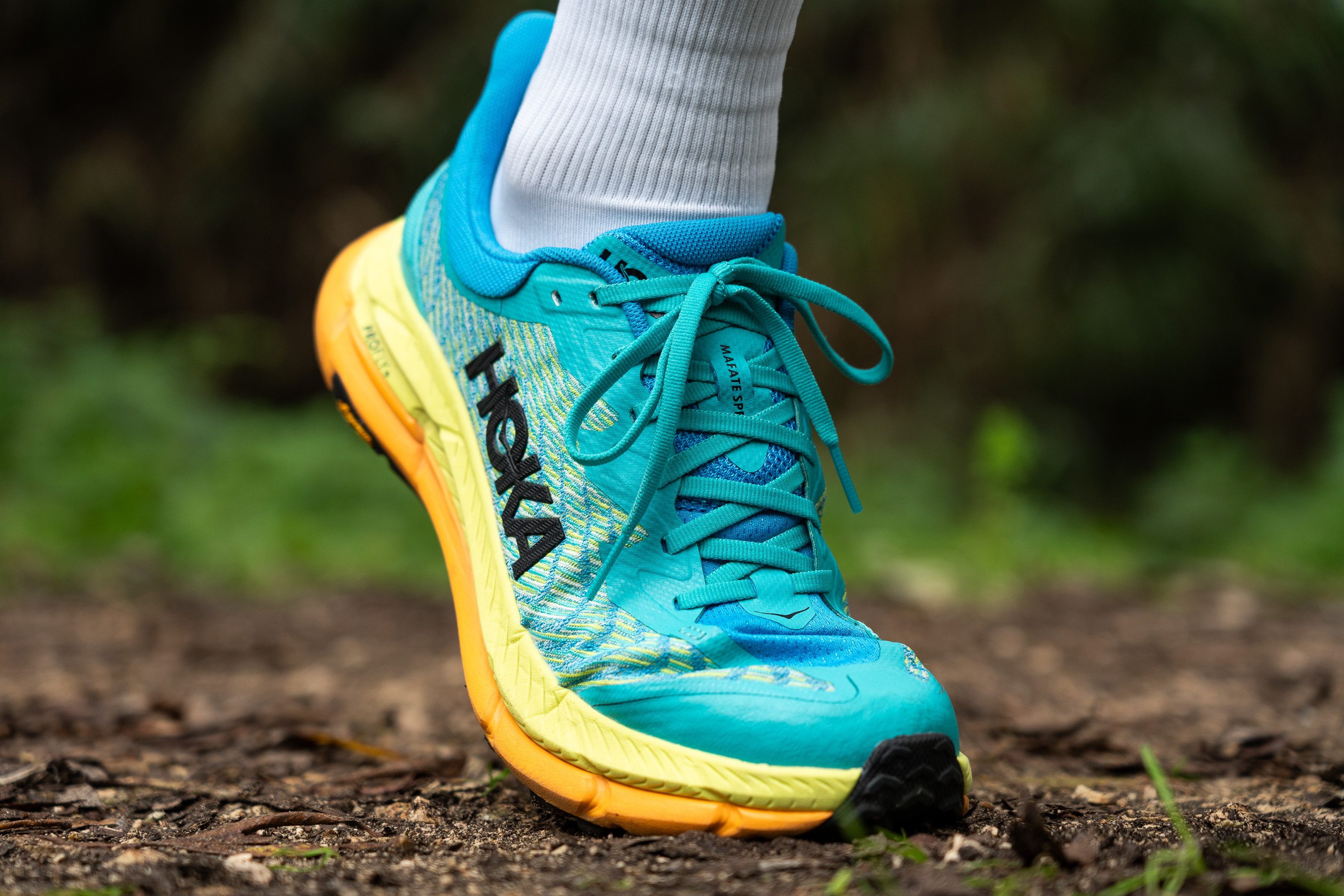
It features a thick, plush layer of foam that works wonderfully in preventing any discomfort in the instep area.
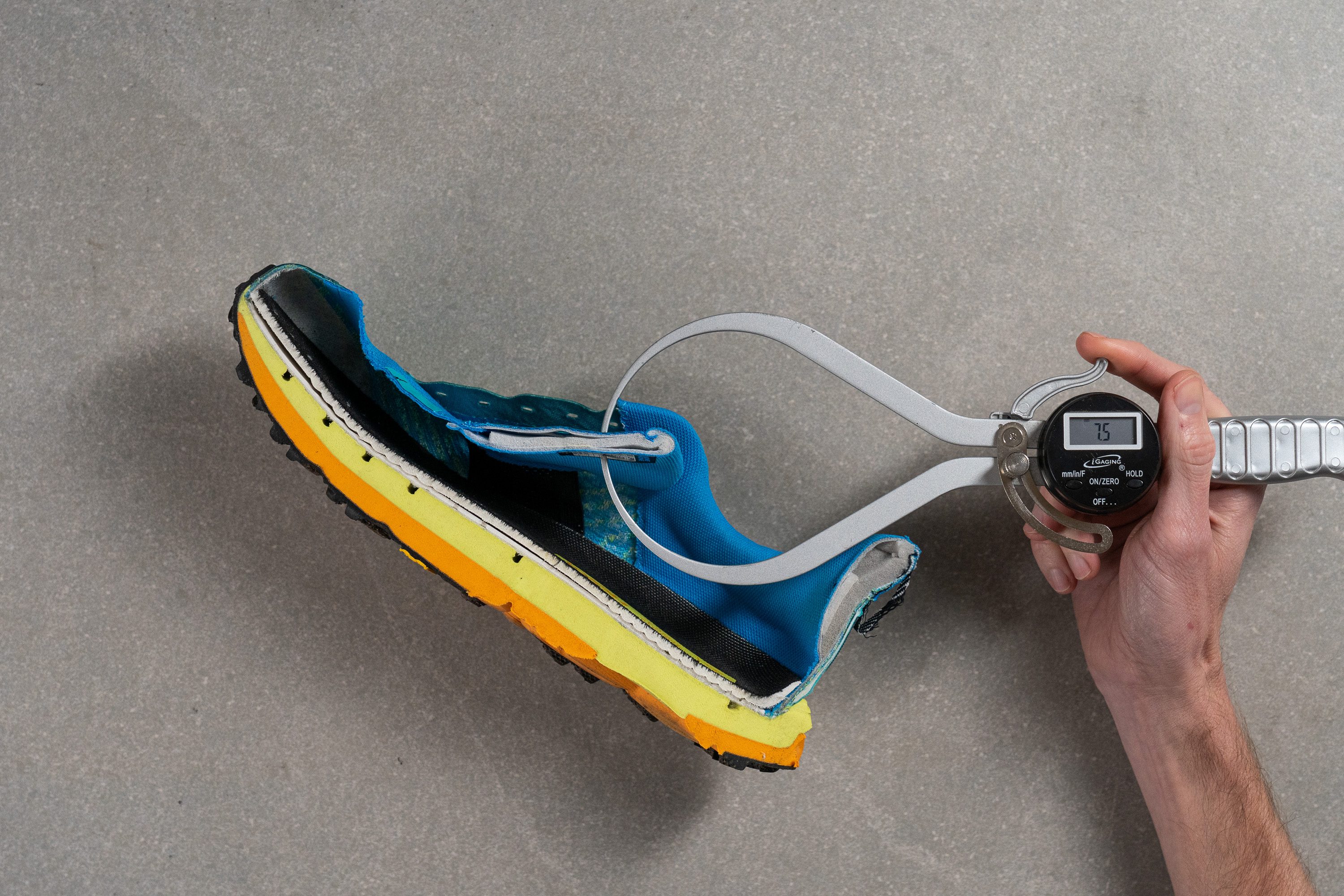
| Hoka Mafate Speed 4 | 7.5 mm |
| Average | 6.4 mm |
Tongue: gusset type
Hoka has a clear preference for semi-gusseted tongues, as evidenced by this model—the gusset is black, but it's there—and we're happy with that decision, as they strike a nice balance between ensuring a secure lockdown and keeping the weight low.
However, for shoes designed for rugged terrain, we generally lean towards fully gusseted tongues for enhanced security and comfort.
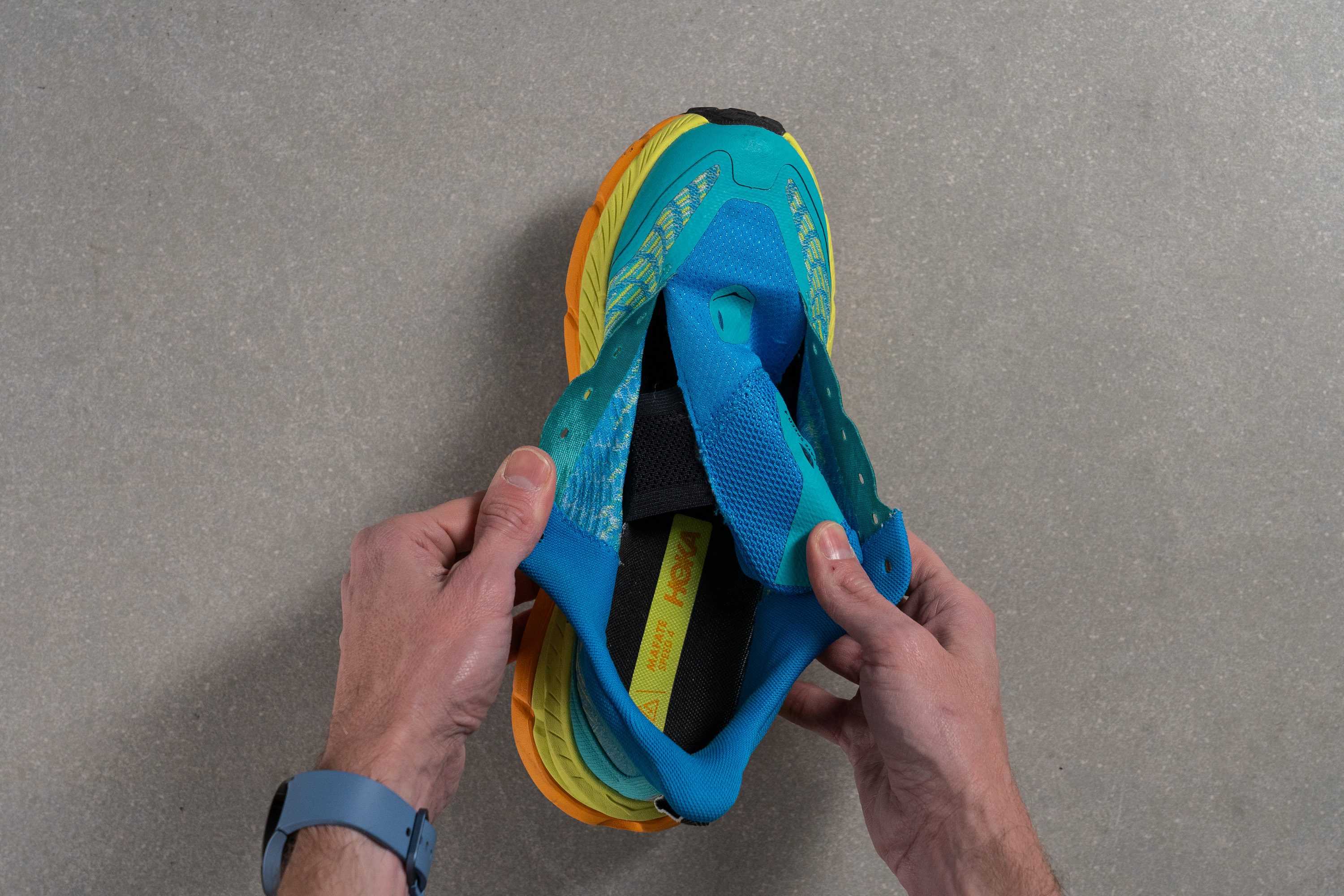
| Hoka Mafate Speed 4 | Both sides (semi) |
Heel tab
The heel features a finger-loop tab, which appears to serve more as a style element than a functional one.
But there's a downside to this area we need to mention—the design of the ankle collar acts like a funnel, constantly allowing debris to enter the shoe, which can be quite bothersome.
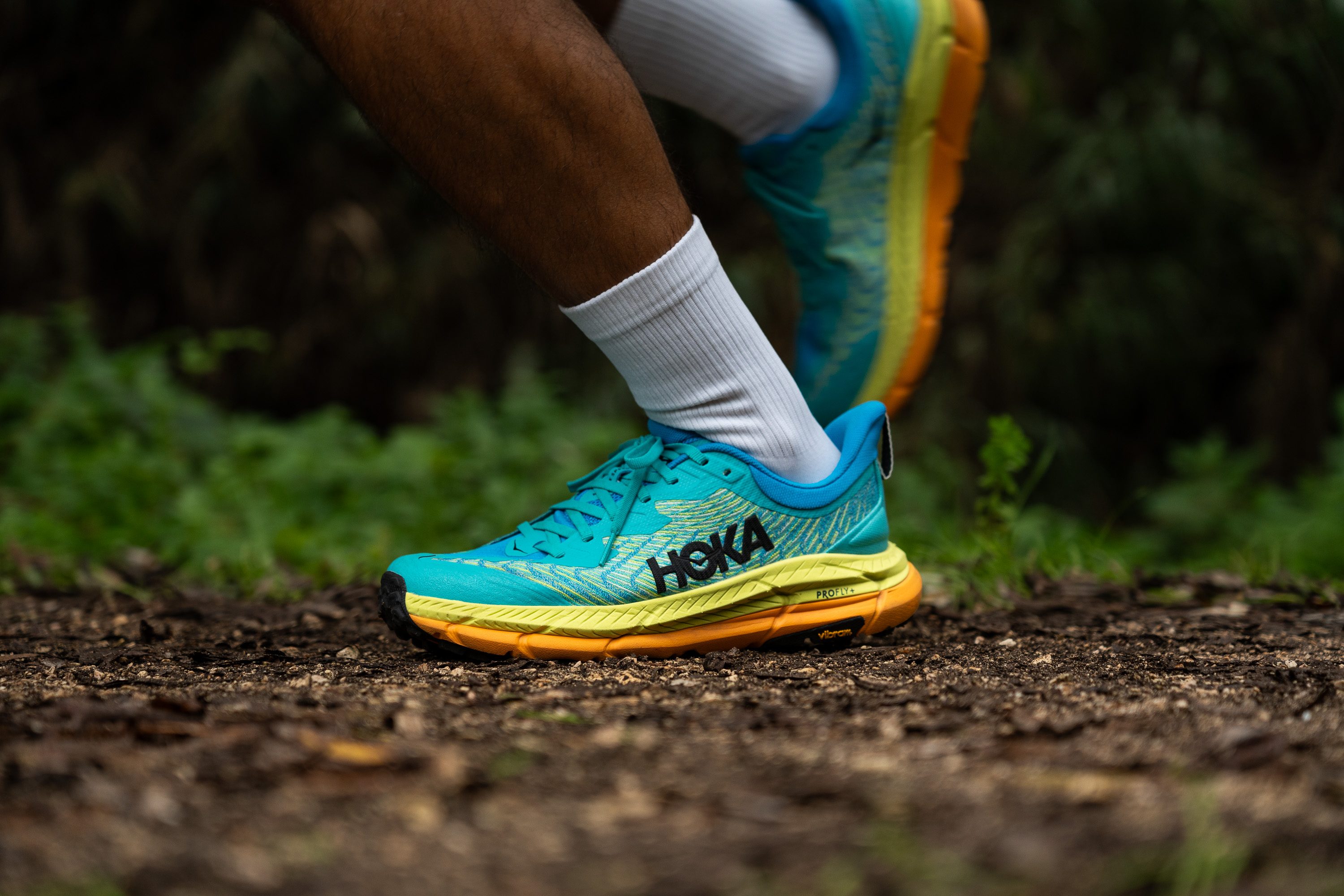
| Hoka Mafate Speed 4 | Finger loop |

























































